An African safari is one of those experiences that I believe must be added to your bucket-list and experienced at least once in your lifetime! Seeing iconic animals such as lions and elephants in the wild, where they belong, takes my breath away every time.
There are a number of destinations across Africa in which you can go on safari but Kenya is one of the most popular and with very good reason.
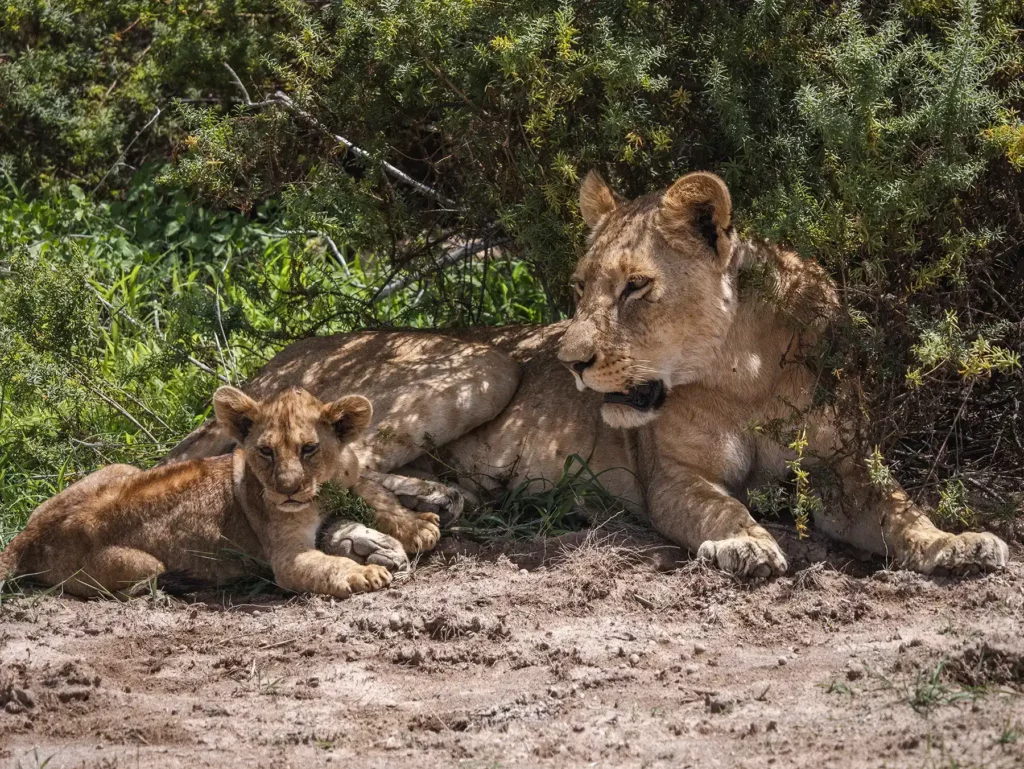
Kenya is home to a number of national parks and reserves, many of which are world-famous. The Maasai Mara has a reputation for being one of the best places to spot Africa’s big cats whilst Amboseli is home to some of the world’s largest herds of elephants.
April 2024 update: Whilst Kenya was once touted as a cheaper destination to go on safari in comparison to neighbouring Tanzania and Uganda, this is no longer the case due to increases in Kenya park fees which fully kicked-in on 1st July 2024.
The three destinations are now comparable when it comes to prices. This guide contains all the updated costs.
To give you a very quick idea of a Kenya safari cost, a typical private safari in Kenya starts at $300 per person per day. This includes park fees, full board accommodation, your vehicle, driver guide and any taxes.
If a private Kenya safari is outside of your budget then there are cheaper options available. Shared group safaris with budget camping can cost as little as $180 per person per day, especially if you minimise the number of days in the most expensive parks.
In this article I’m going to go into more detail on how much safaris in Kenya cost, including a breakdown of costs as well as what you can expect on a luxury safari vs a budget safari.
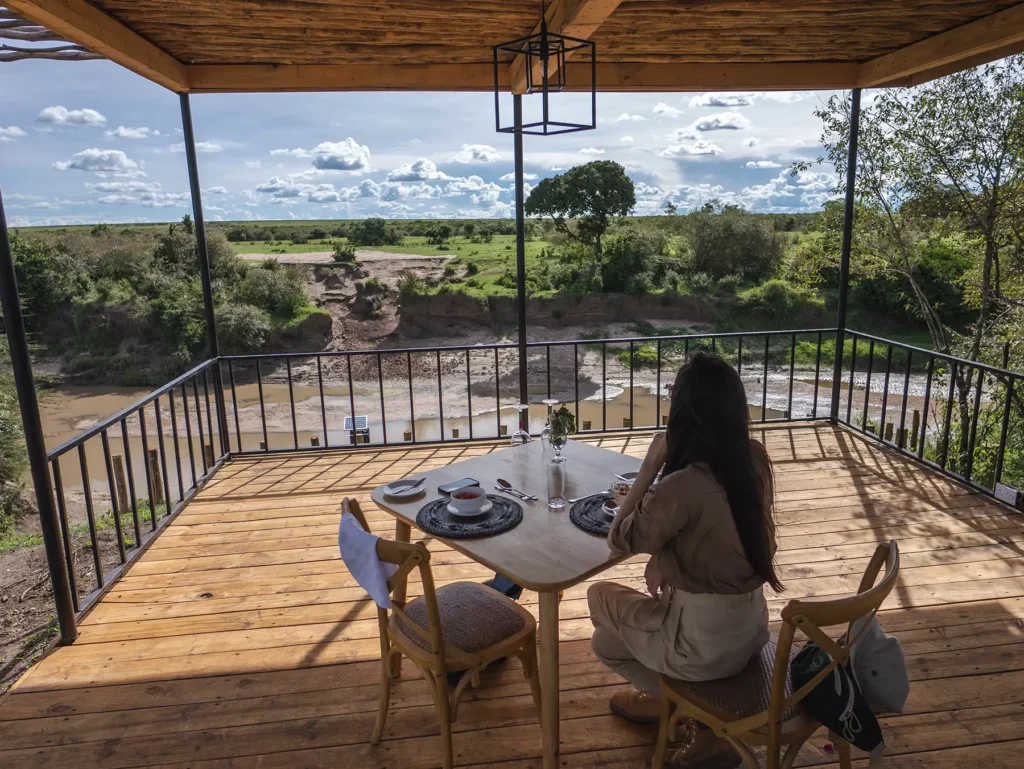
Kenya Safari Costs At a Glance
The chart below shows you typical prices for a Kenya safari when working with a local tour operator.
By contrast, larger international travel agents or safari companies based in your local country, such as the US / UK will normally add 30 – 300% to the local operator prices below. We’ll cover the pros and cons of both booking options later.
The cost per day (usually given as the cost per person per day), will vary depending on a number of factors, including the number of people in your group, which national parks you visit and your mode of transport e.g. road or air.
The total cost for your safari is mostly dictated by how many days you choose to spend on safari. As a starting point, I’d recommend a 5 day Kenya safari itinerary and opt for a 7 – 10 day Kenya itinerary if your budget and diary permits.
Whilst not my first choice, a 3 day itinerary is also possible due to the high destiny of wildlife and short driving distance from Nairobi to the Maasai Mara National Reserve.
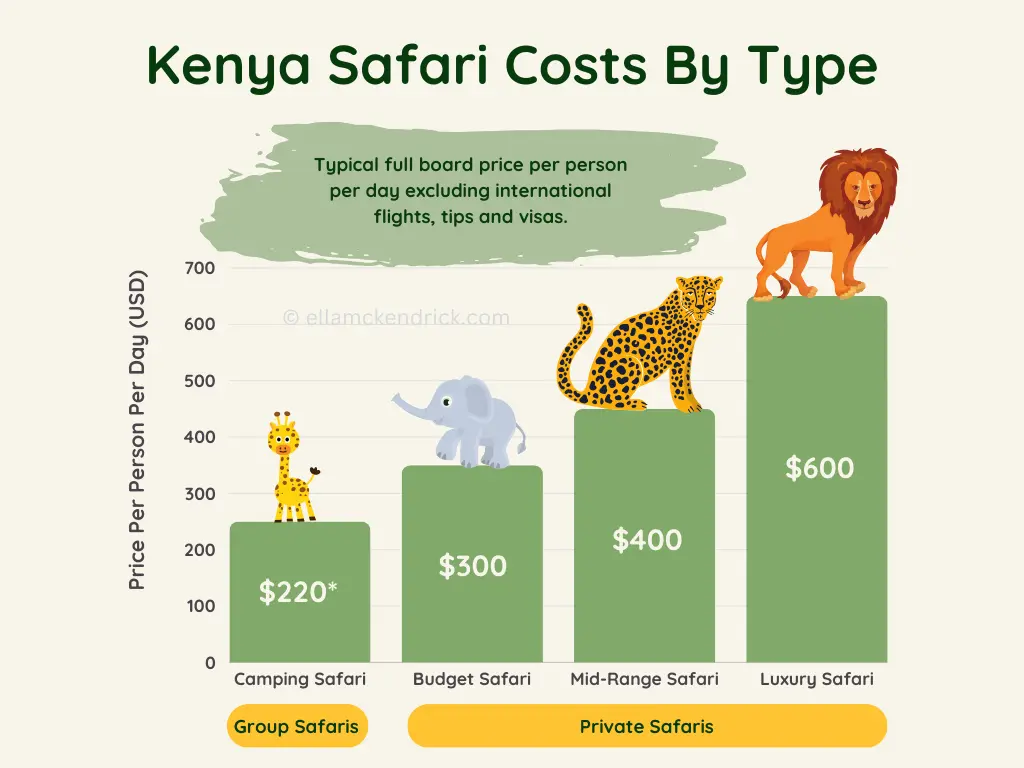
*Whilst you can find group (shared) camping safaris for as little $180 per person the experience is not usually great, due to cost-cutting by the tour company, so I’ve shown $220 as this is the price at which they provide a great experience.
We’ll dig into these prices in just a moment to help you better understand how the costs breakdown and how you can achieve the best value for your budget.
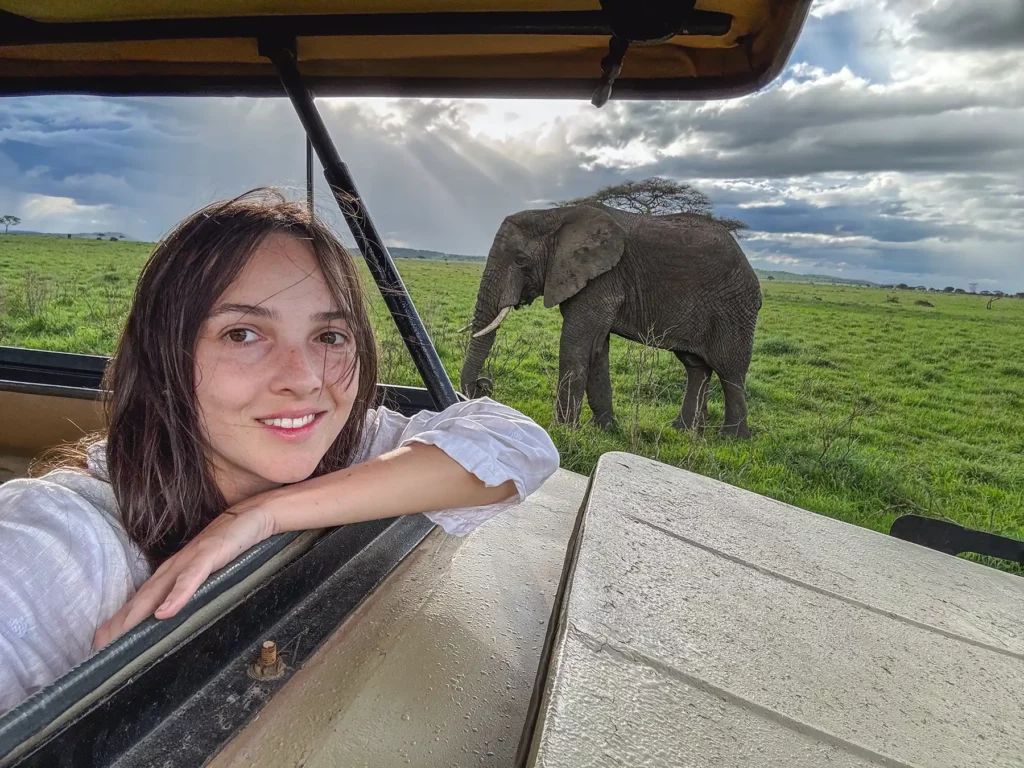
Embark on the Safari of Your Dreams
Save time and ensure an incredible safari experience by getting quotes from my recommended local safari companies
I’m here to make booking your perfect safari quick, easy and risk-free.
Join the rapidly growing tribe of over 1,000 travellers who’ve booked their dream safari using my insider tips and recommendations.

It takes under 60 seconds to fill out the form and in under 48 hours you will receive multiple, no-obligation proposals from my favourite local tour operators with glowing online reviews.
Get your free no-obligation safari quotes and my top safari tips and recommendations
In this Guide
- Kenya Safari Costs At a Glance
- How Much Will Your Kenya Safari Cost?
- Factors Affecting Your Kenya Safari Cost
- How do Kenya Safari Costs Compare with Other African Safaris?
- Cultural Experience Tours Costs
- Special Interest Safari Costs
- Mount Kenya Hiking Costs
- Other Safari Costs
- How Much Cash To Take
- Final Thoughts
How Much Will Your Kenya Safari Cost?
Safaris, whilst definitely not a cheap holiday, are an incredible once in a lifetime experience.
Kenya might not be the cheapest places to go on safari, especially after the park fee increase. However, the country is without a doubt, one of the best safari destinations in the world.
Kenya’s safari highlights include the incredible word-class Masai Mara National Reserve, home to the Big Five and Amboseli National Park with it’s famous Big Tuskers.

Let’s start by digging in to the park fee increase and what effect this will have on your total Kenya safari cost.
Starting January 2024, park fees in Kenya are increasing across the board by around 100% with the increase fully implemented on 1st July 2024.
For example, the Masai Mara used to cost $80 + 18% tax ($94.40) per adult per entry per day in all seasons. Starting in 2024, these fees will increase to $200 + 18% tax ($236) per adult per entry per day in the peak season (July to December) and $100 + 18% tax ($118) in the low season (January to June).
Although I couldn’t find any official explanation for this increase, the general consensus is that the parks were simply getting too busy with safaris. Therefore Narok County Government and the Kenya Wildlife Service have raised the prices to reduce the numbers of safaris whilst maintaining the same income to protect the national parks and reserves.
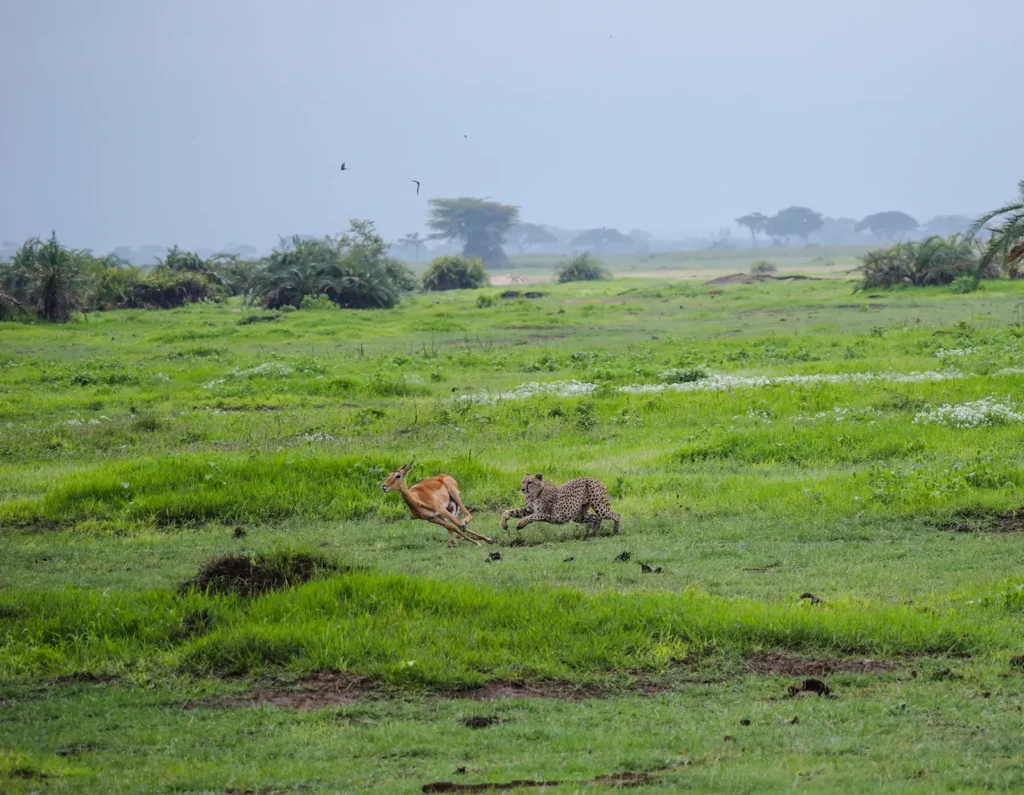
With park fees being around 30% of your total safari cost, this increase would add around 30% on to the cost of a typical safari which now start at around $300 per adult per day.
This increase brings Kenya safari costs more inline with bordering Tanzania safari costs, with private safaris over the border starting at $350 by comparison.
Some Kenyan tour operators are planning to include less time in the more expensive parks such as the Masai Mara to offset some of the cost increases.
Although prices going up is rarely something to celebrate, this does have the benefit of giving you a better experience in the peak periods as the parks will now be less crowded, leading to better wildlife viewing opportunities.
It also rewards you financially for spending time exploring some of the lesser-known and lower-cost parks, which can still provide incredible wildlife viewing.
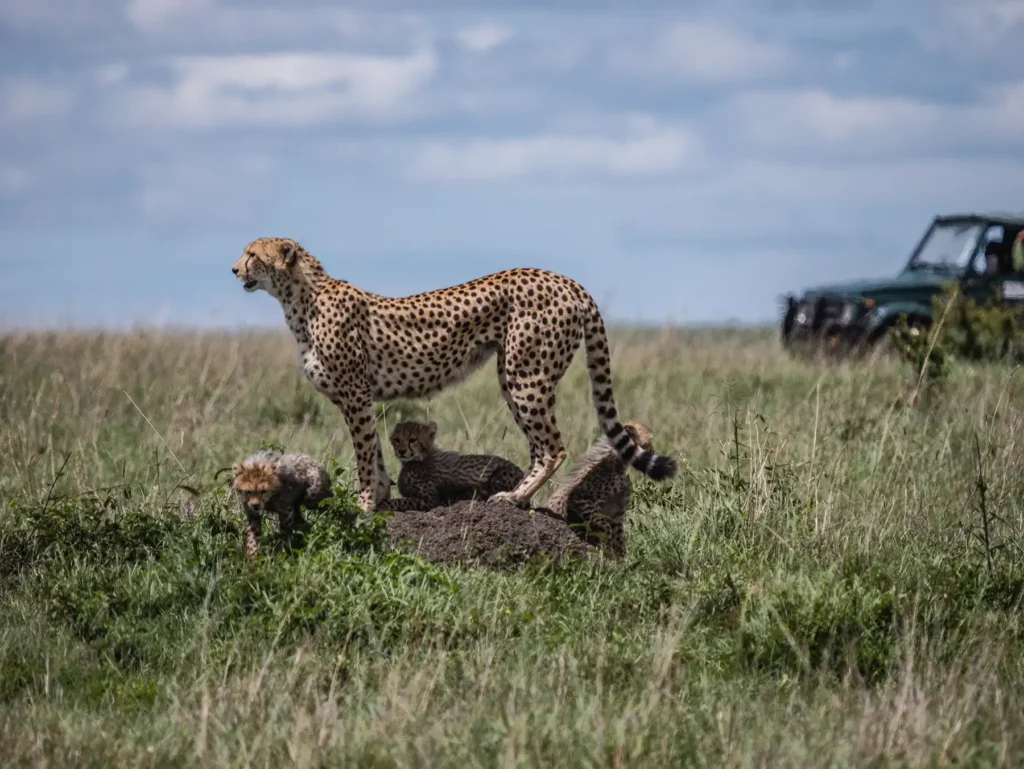
Whilst we’ve covered starting prices, I want to delve a bit deeper and show what costs to expect as you increase comfort levels and also how your choice of booking method affects the costs.
The different comfort levels available are: budget (which can be split into budget camping or budget lodges), mid-range and luxury (which can be split into luxury and luxury plus).
The comfort levels mostly refer to the accommodation but can affect the standard of the safari vehicle too, with minibuses often being used at the lower end and 4×4 Toyota Land Cruisers being used at the medium to higher ends.
For each of these comfort levels, I’m going to show the costs when booking through a DIY self-drive approach, joining a group (shared) tour by a local company, booking a private safari with a local company and finally booking through an International travel agent.

You can jump to the different sections below:
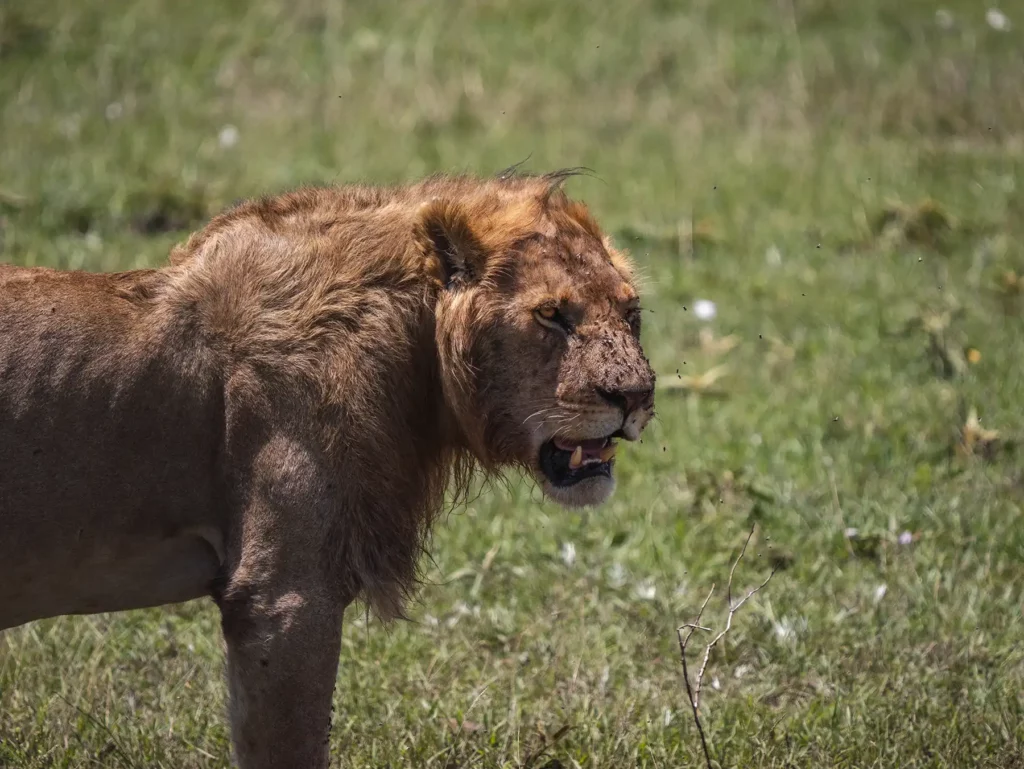
Budget Kenya Safari Costs
Budget safaris are entry-level safaris and the cheapest way to experience a typical African safari where you drive around in a safari truck in the national parks and view the wildlife.
Within the budget category you have budget camping and budget lodges. Budget lodges might include some large semi-permanent tented camps too which are comfortable with proper beds and western bathrooms.
Typically budget camping accommodation will be provided if you opt for a shared (group) safari. Shared safaris are run at a set time and date and usually last 3 or 6 days. They lack the flexibility and comfort of private safaris but can work out very cost-effective if you are a solo traveller as private budget safaris for solo travellers usually start around $500 per day.
For parties of 2 or more, private safaris are a cost-effective option as you are sharing the fixed costs such as the driver / guide and the safari truck between multiple people in your party. Private budget safaris will typically use budget lodges or semi-permanent tented camps.
In my experience, the satisfaction ratings for private budget safaris are consistently higher than group budget camping safaris. This is due to the aggressive cost-cutting with group safaris which gives them a lower price than private budget safaris but gives a no frills experience including less experienced guides.
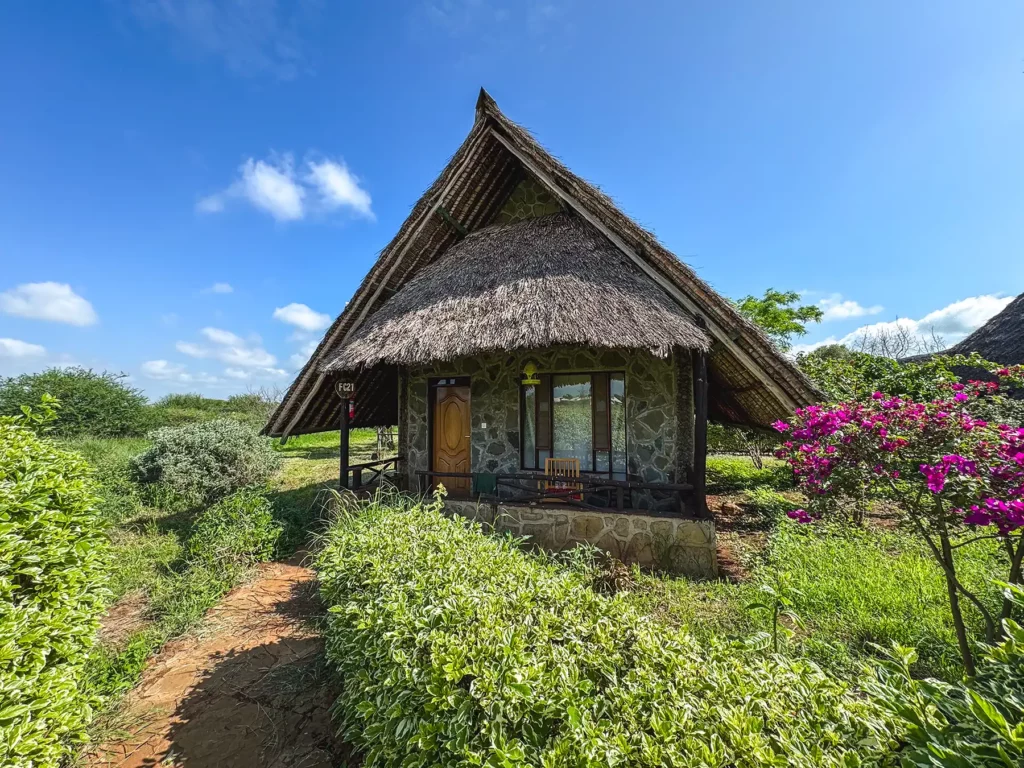
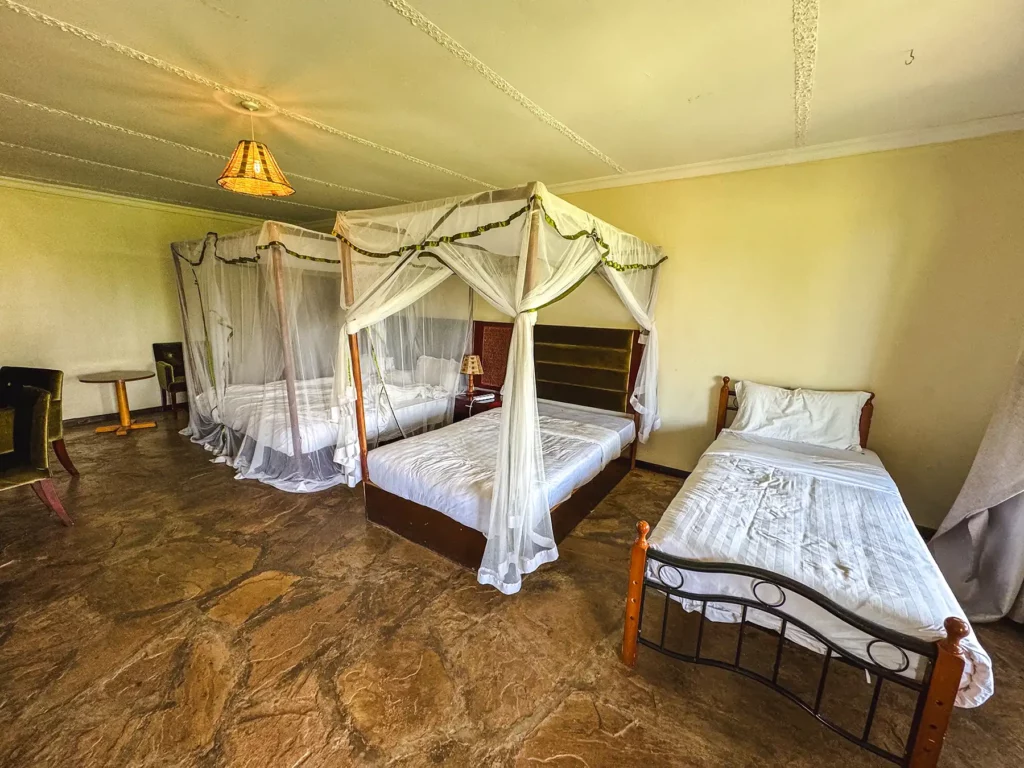
What’s the difference between a budget and mid-range safari
The two biggest differences with a budget safari in Kenya are the accommodation choices and safari vehicle.
You might also have a less experienced guide to reduce costs and possibly visit less expensive parks or at least spend less time in the most expensive parks such as the Maasai Mara.
On a budget safari, you will move between parks via road where possible as internal flights are expensive.
One of the cost benefits of going on a budget safari in Kenya vs Tanzania is that Kenya allows lower cost minibuses inside the National Parks. Whereas in Tanzania they only allow more expensive 4×4 Land Cruisers which make budget safaris slightly more expensive. Whilst the minibuses are not quite as robust and capable as the Toyota Land Cruisers, they are a cost effective means of transport around the parks and feature pop-up roofs for game viewing.
Accommodation is the biggest difference you’ll notice between a budget and mid-range safari. This can range from small tents with sleeping bags in the case of a group camping safari through to comfortable budget lodges and tented camps, often with private bathrooms in the case of private budget safaris. Mid-range accommodations are a lot more comfortable, with bigger rooms, large, comfortable beds and guaranteed private bathrooms.
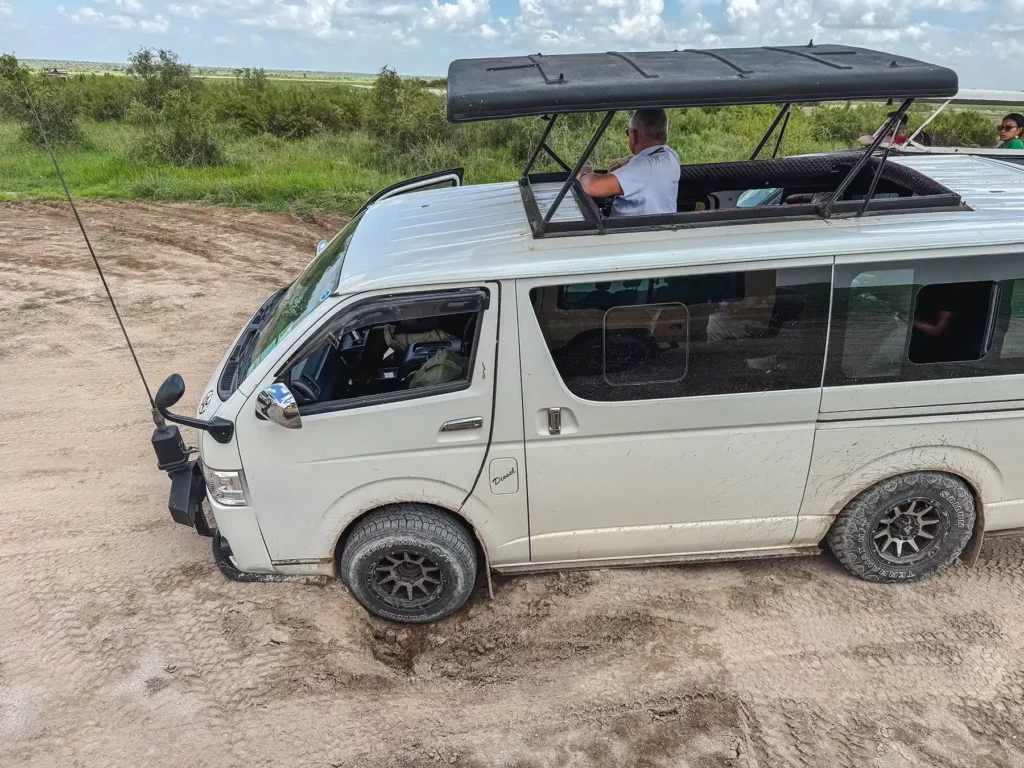
What’s the same with a budget safari
You’ll still have a driver / guide unless you decide to self drive and you’ll probably visit the same parks although you might spend less time in the expensive parks.
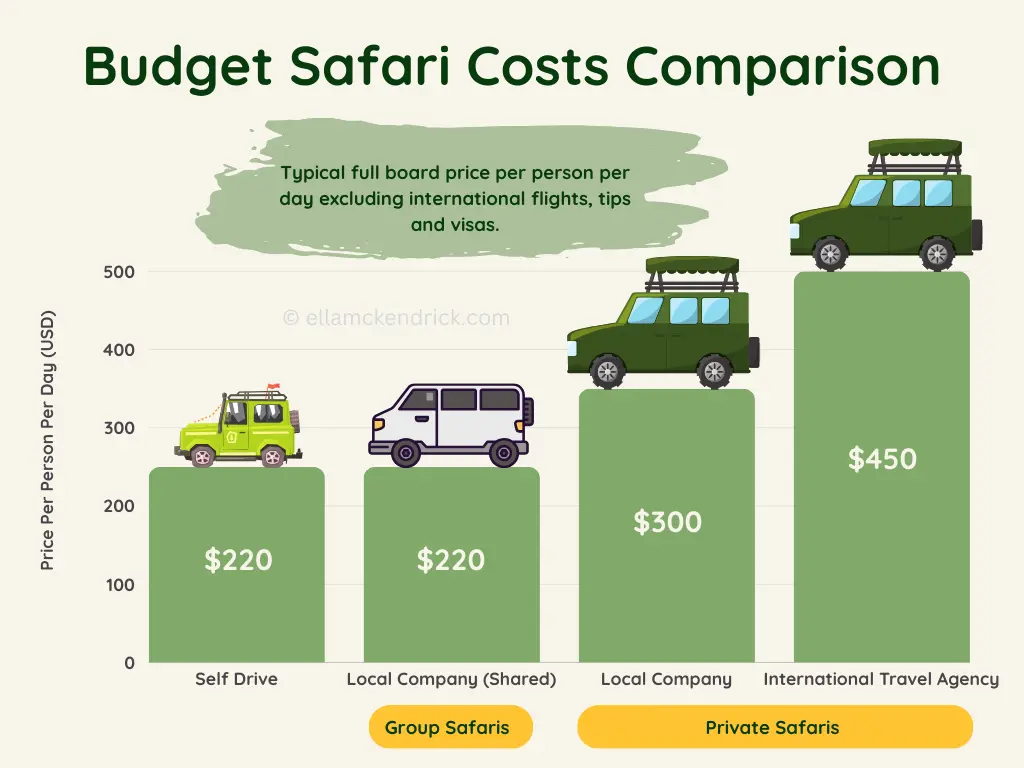
Notes on the budget safari costs
- You can save around 12-27% if you choose a shared (group) safari package where you share the truck with strangers. However, accommodation is usually basic ground tents and communal bathrooms, and they usually have fixed 3 and 6 day itineraries and depart at scheduled times. On a like-for-like accommodation basis the savings are around 12%.
- The private self-drive option is cheaper than the private local supplier safari because you’re saving on the driver/guide. However, since you’re paying a lot of money anyway you might as well pay a little bit extra for a driver guide to make sure you have the best sightings as well as a more relaxing experience. See my section on DIY safari for more on this topic and why I wouldn’t self drive in Kenya.
- The international travel agent / safari company price is higher than the local safari company because you’re paying for their overheads and profit on top of the local company who carries out the safari.
Recommended Booking Options For Budget Kenya Safaris
Private Safari
Most popular & best experience – typical prices for this itinerary start from $300 per person per day.
Visit safarisbyella.com for free quotes from trustworthy local tour companies I use to book my own trips.
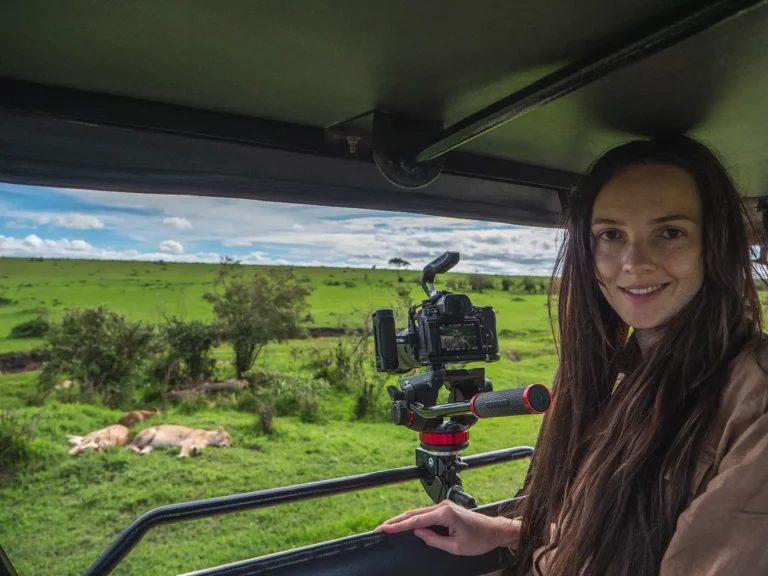
Group (Shared) Safari – Usually Camping
Good for budget or solo travellers – from $180 per person per day.
My recommended Tanzania tour operators only provide private safaris, however, I’ve listed the best and most similar group options for this itinerary, on SafariBookings below.
Click the link below to request quotes for the group safari options on the SafariBookings website.
7-Day Kenya Budget Group Safari to Maasai Mara, Naivasha, Nakuru, & Amboseli
5-Day Kenya Budget Group Camping Safari to Masai Mara & Lake Nakuru
7-Day Kenya Budget Group Safari to Masai Mara, Amboseli, Lake Nakuru & Lake Naivasha
Mid-Range Kenya Safari Costs
Mid-range safaris are the most popular type of safari in Kenya, giving you an incredible experience with very comfortable accommodation.
Mid-range safaris are the best value in my option as they are only around 30% more in price compared to budget safaris, but give you a much higher standard of accommodation, such as tented camps in the national parks with traditional beds and private western bathrooms.
Since you are spending quite a bit of money anyway on park fees and your safari vehicle etc. you might as well spend an extra $75 – $100 per person per day to have fantastic accommodation, a more comfortable and spacious 4×4 Toyota Land Cruiser and a more experienced guide.
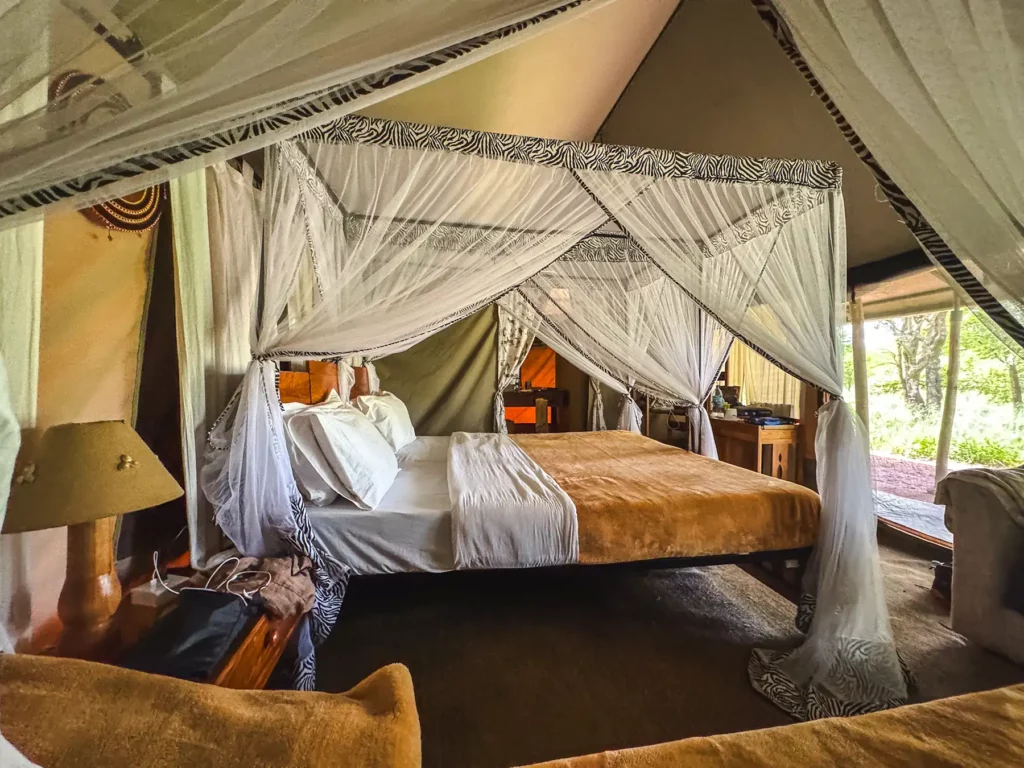

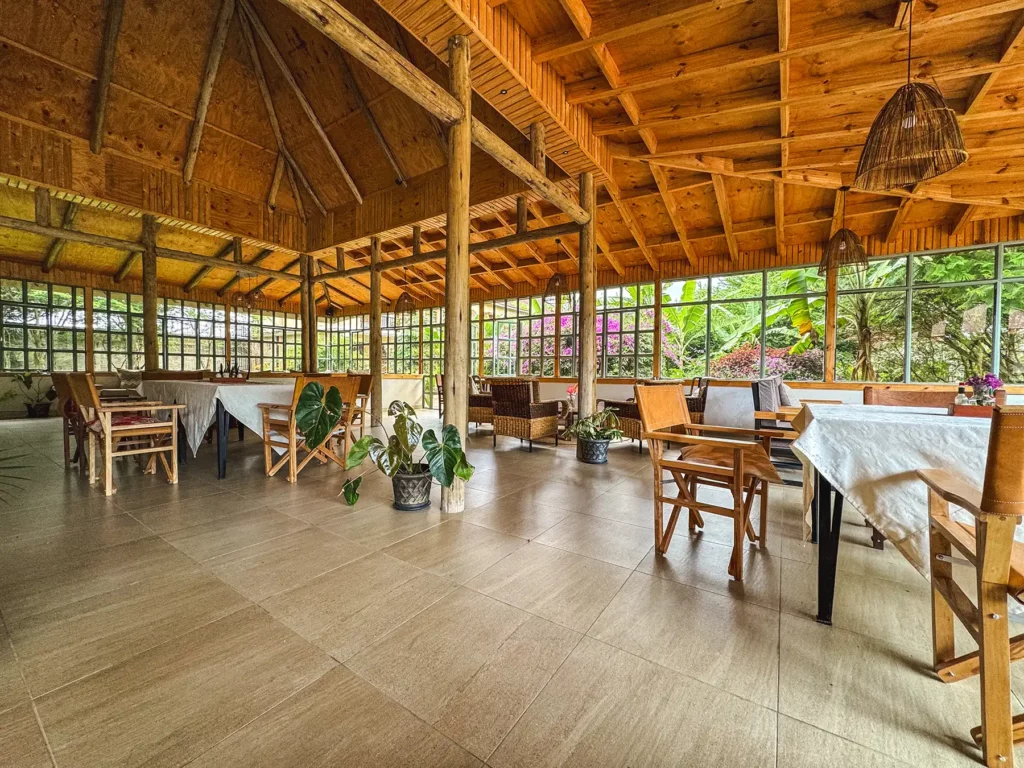
What’s the difference with a mid-range safari
The two main differences with a mid-range safari in Kenya is the accommodation and your safari vehicle.
You will have very comfortable accommodation in mid-range tented camps and lodges with private western bathrooms. Your safari will usually include accommodation inside the national parks.
You’ll usually have an upgraded safari vehicle such as a 4×4 Toyota Land Cruiser with a pop-up roof for game viewing.
You’ll visit the very best parks such as the Maasai Mara and spend more time on those parks compared to a budget safari.
Mid-range safaris may include an internal flight to avoid any particularly long drives such as at the start or end of the safari.
Compared to a budget safari, you will often be allocated a more experienced guide to provide optimal game viewing.
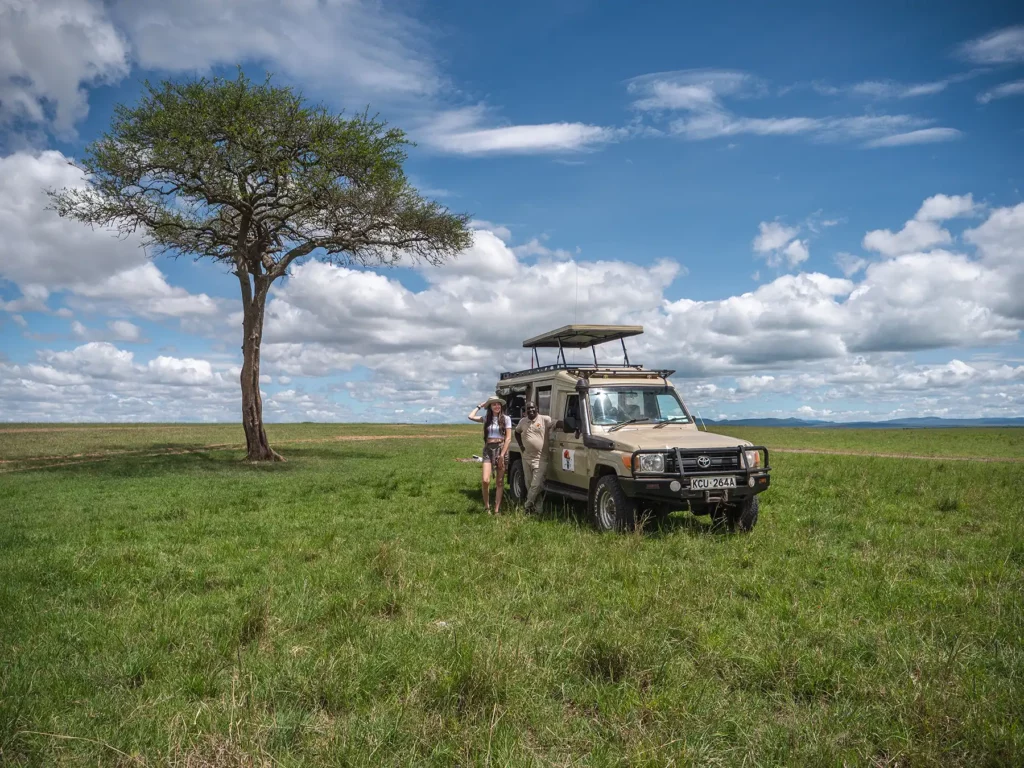
What’s the same with a mid-range safari: You’ll typically go to many of the same parks as a budget safari but may spend more time in the more expensive parks.
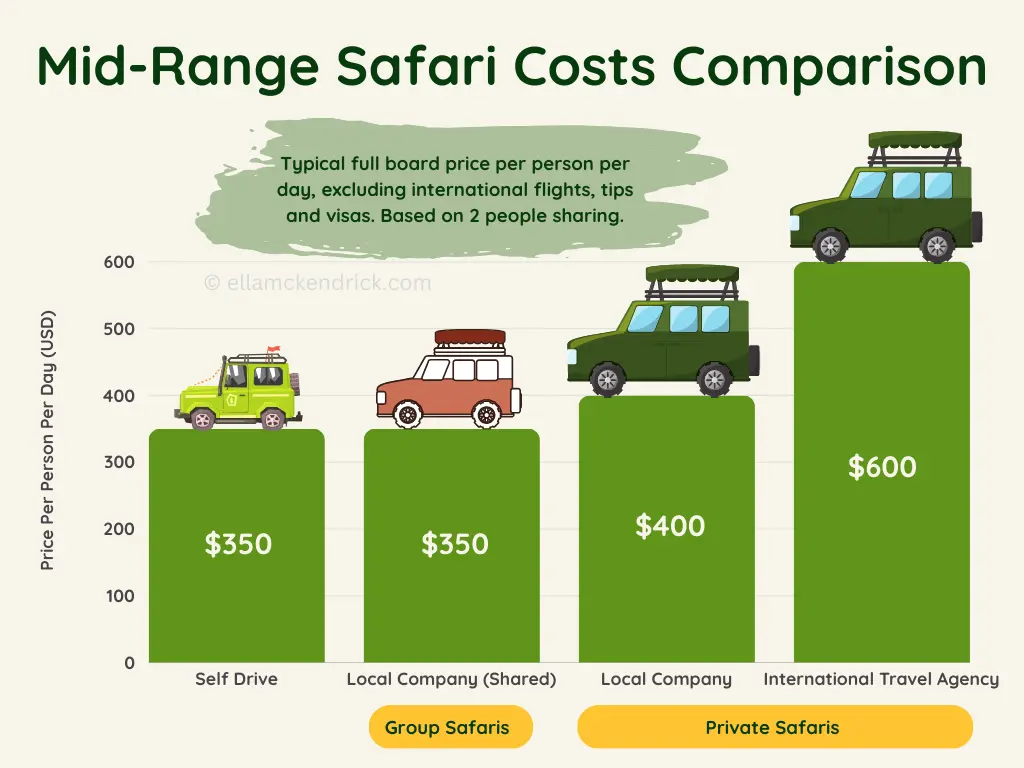
Notes on mid-range safari costs
- The self drive option is cheaper than the private local tour operator because you’re saving on the driver/guide. However, since you’re paying a lot of money anyway you might as well pay a little bit extra for a driver guide to make sure you have the best sightings as well as a more relaxing experience. See my section on DIY safari for more on this topic and why I wouldn’t self drive in Kenya.
- The international travel agent / safari company price is higher than the local safari company because you’re paying for their overheads and profit on top of the local company who does the safari.
Recommended Booking Options For Mid-Range Kenya Safaris
Private Safari
Most popular & best experience – typical prices for this itinerary start from $400 per person per day.
Visit safarisbyella.com for free quotes from trustworthy local tour companies I use to book my own trips.

Luxury Kenya Safari Costs
Kenya does luxury safaris very well with a wide range of incredible safari accommodation available to suit any luxury budget. I always like to include some luxury accommodation in my safaris.
Luxury safaris booked with a local operator typically cost from $600 per adult per day through to $1,500. Luxury + safaris start from $1,500 per person per day and can go up to $5,000 and beyond.
Charter flights replace longer internal drives with internal flights which land on runways inside the parks.
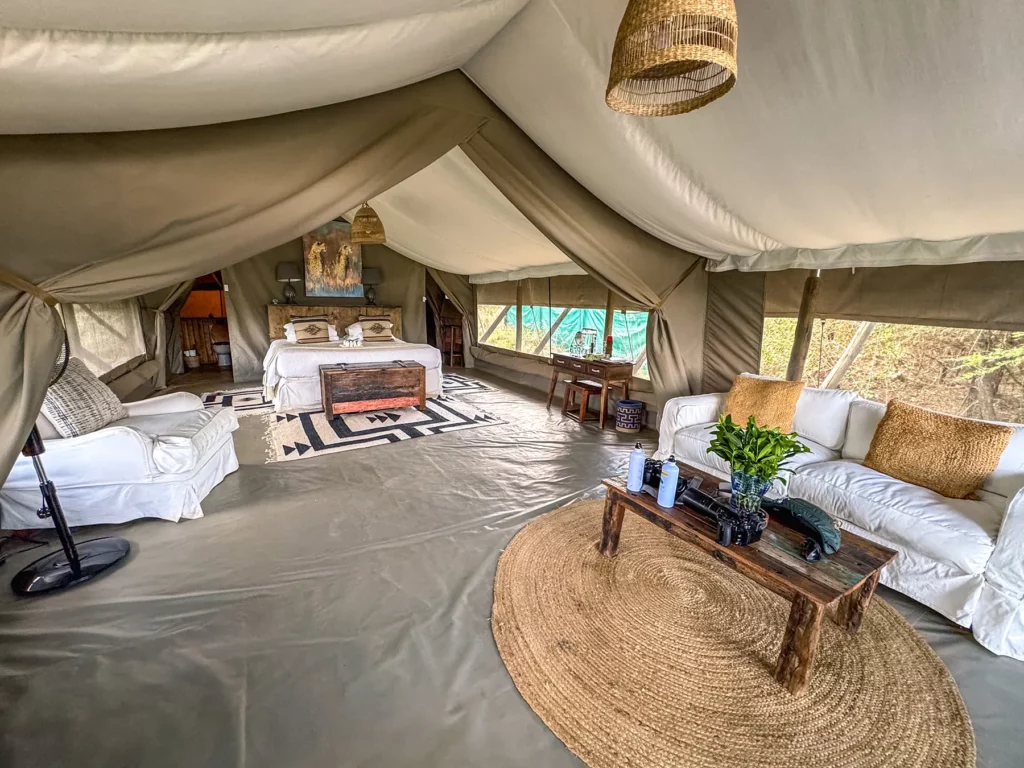
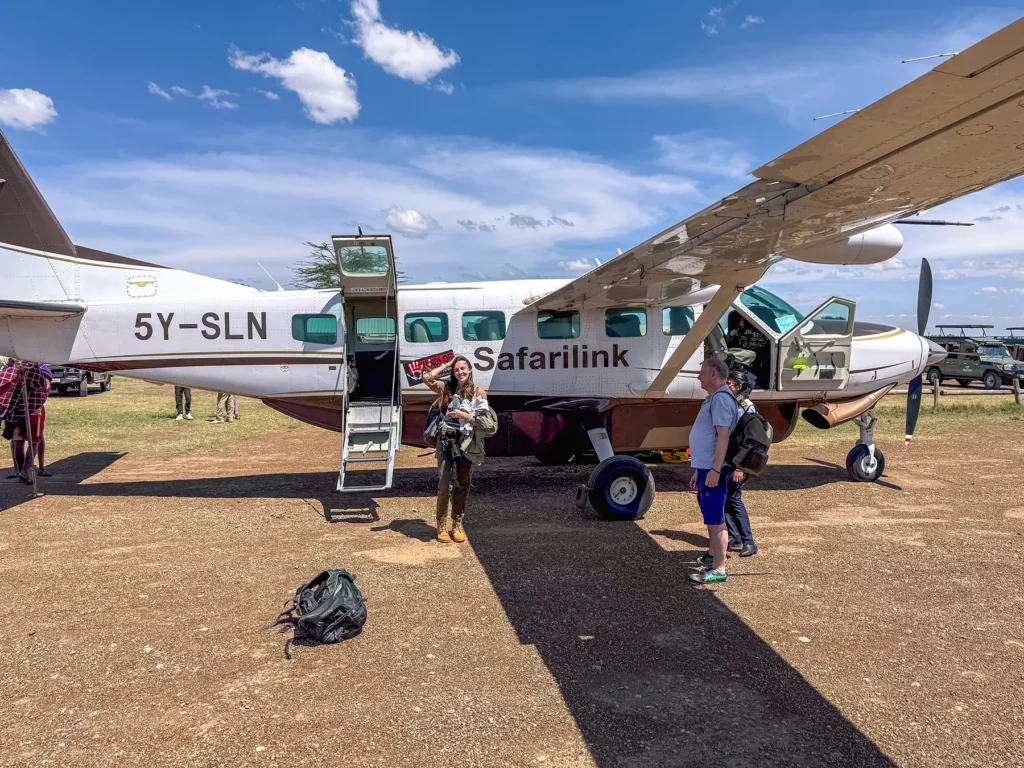
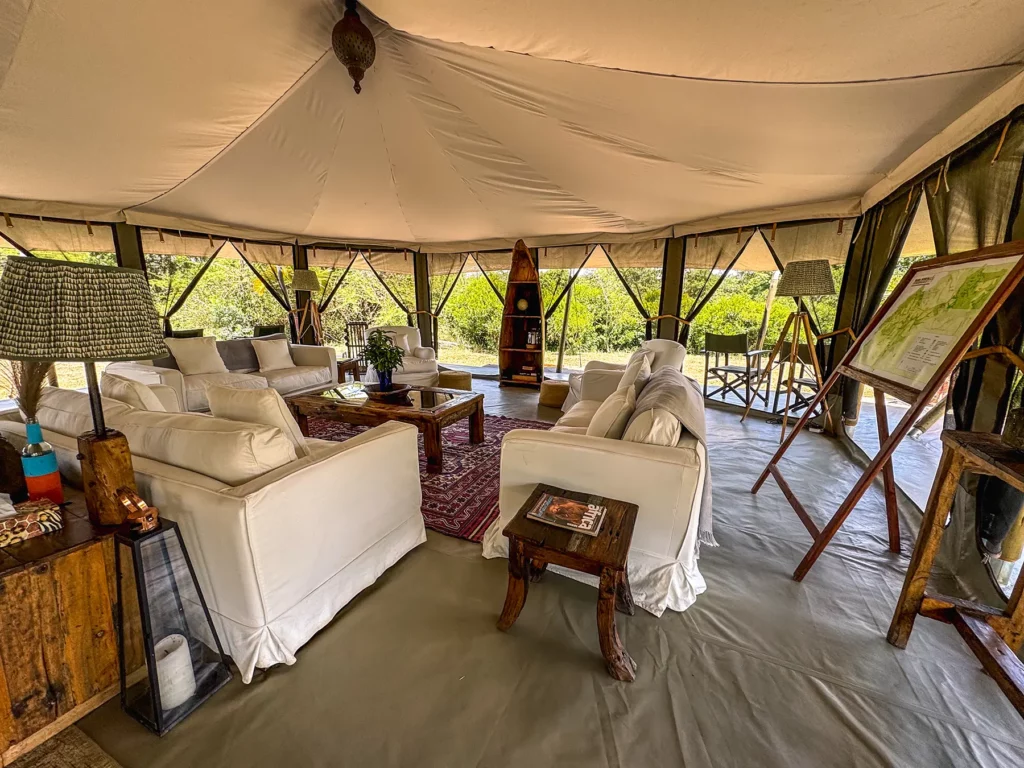
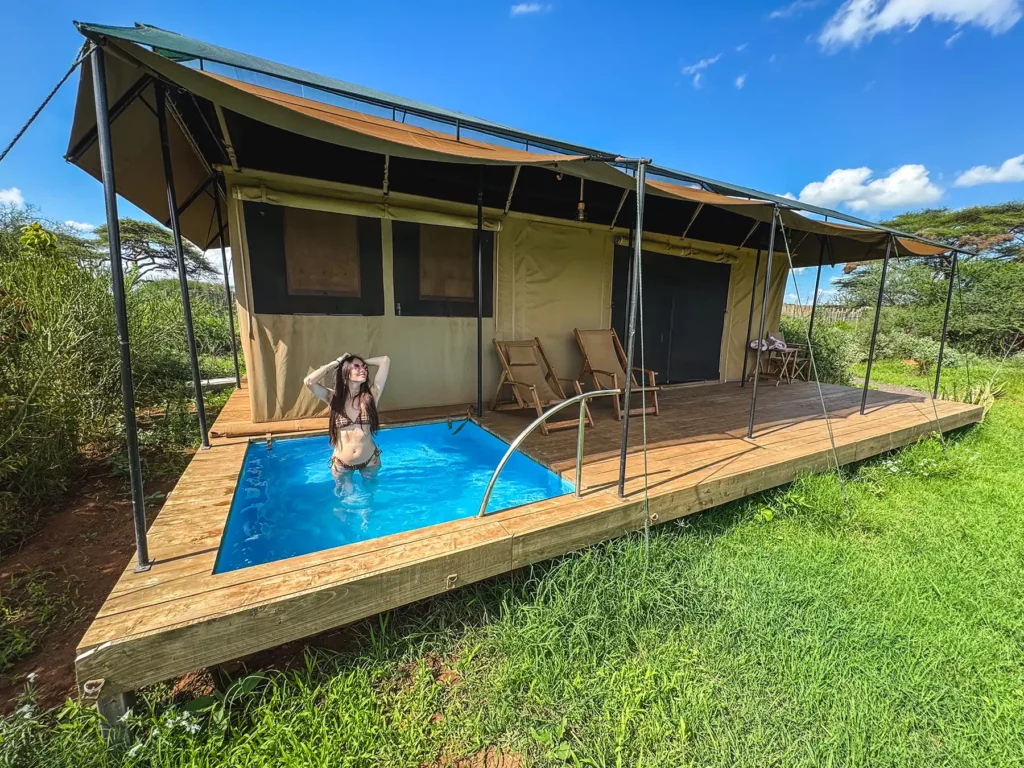
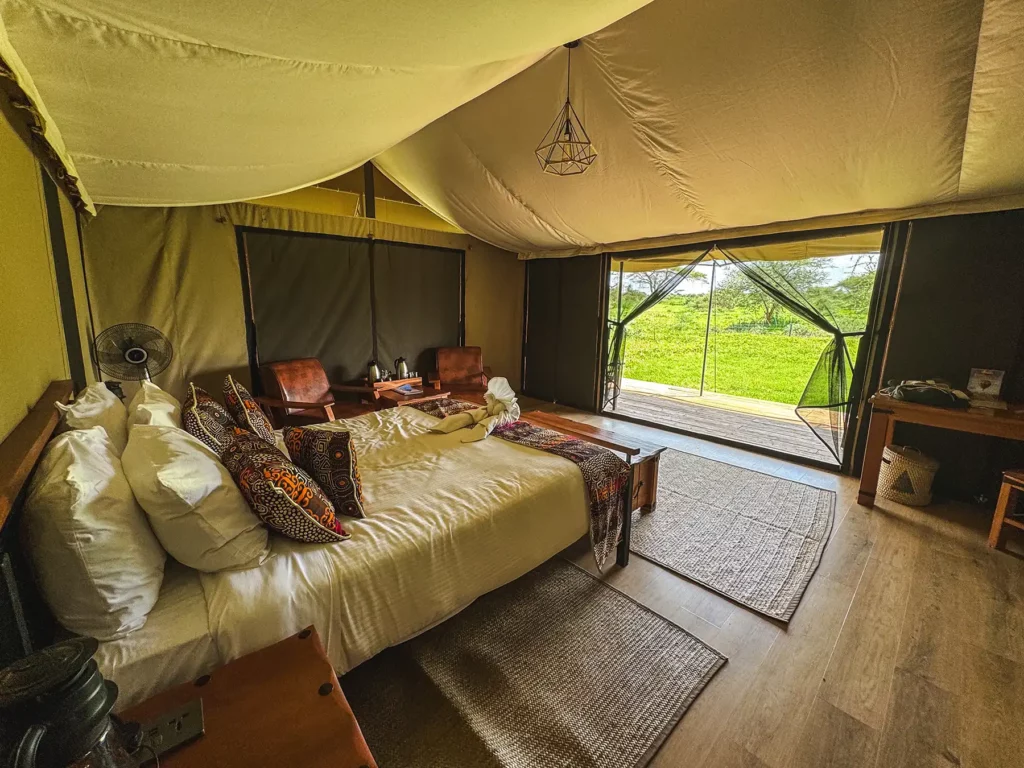
What’s the difference with a Luxury safari
The main difference between a mid-range and luxury safari in Kenya is the level of accommodation and the number of internal flights.
You will be staying in the very best luxury accommodation in Kenya which will often be located inside the national parks and reserves.
Types of accommodation include lodges and tented camps with luxury features including infinity swimming pools, spas, plunge pools and incredible views. The suites will be larger and food will often be cooked to order instead of buffets.
You will usually spend all of your time in the very best national parks such as the Masai Mara.
You will benefit from the most experienced guides to ensure unrivalled game viewing as well as the highest specification Toyota land Cruiser 4×4 safari vehicles including special photography trucks where required.
Luxury safaris may include some internal flights to avoid longer drives. These flights can add around $350 per flight, per person one way.
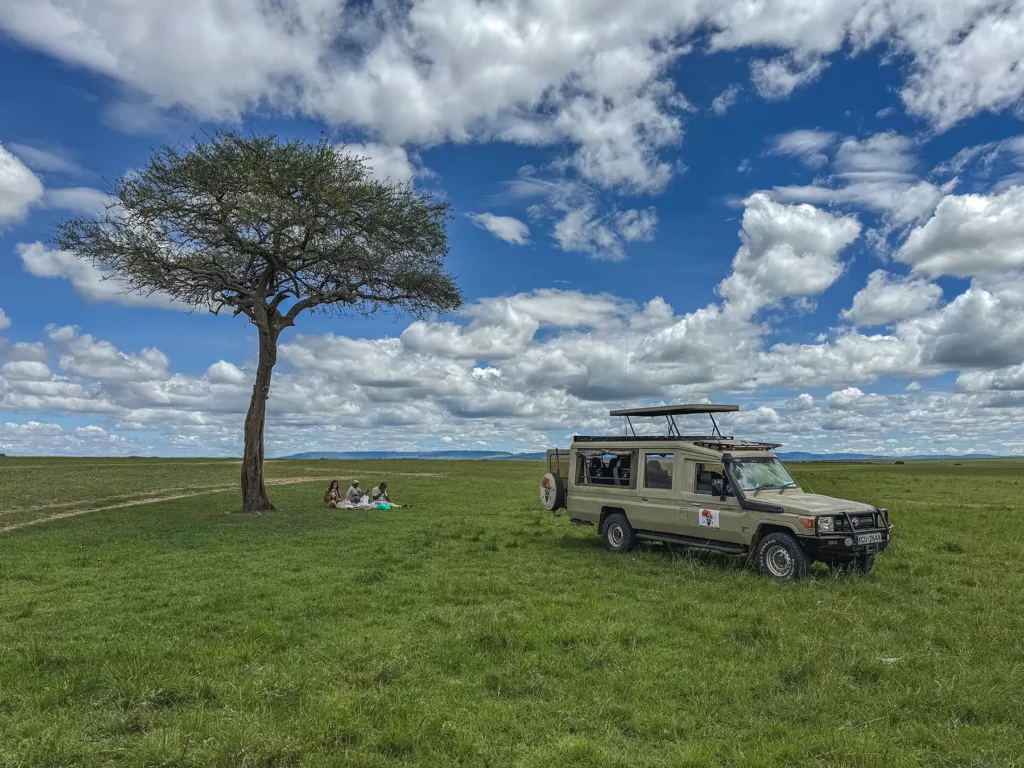
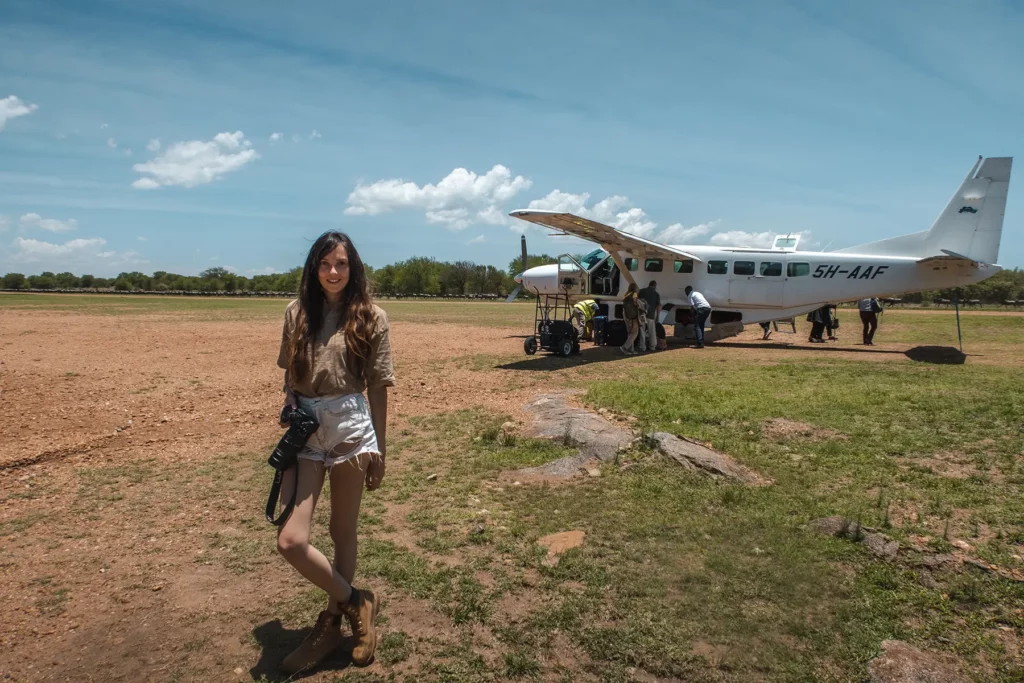
What’s the same with a Luxury safari
Your safari truck will be similar to mid-range but usually a higher specification.
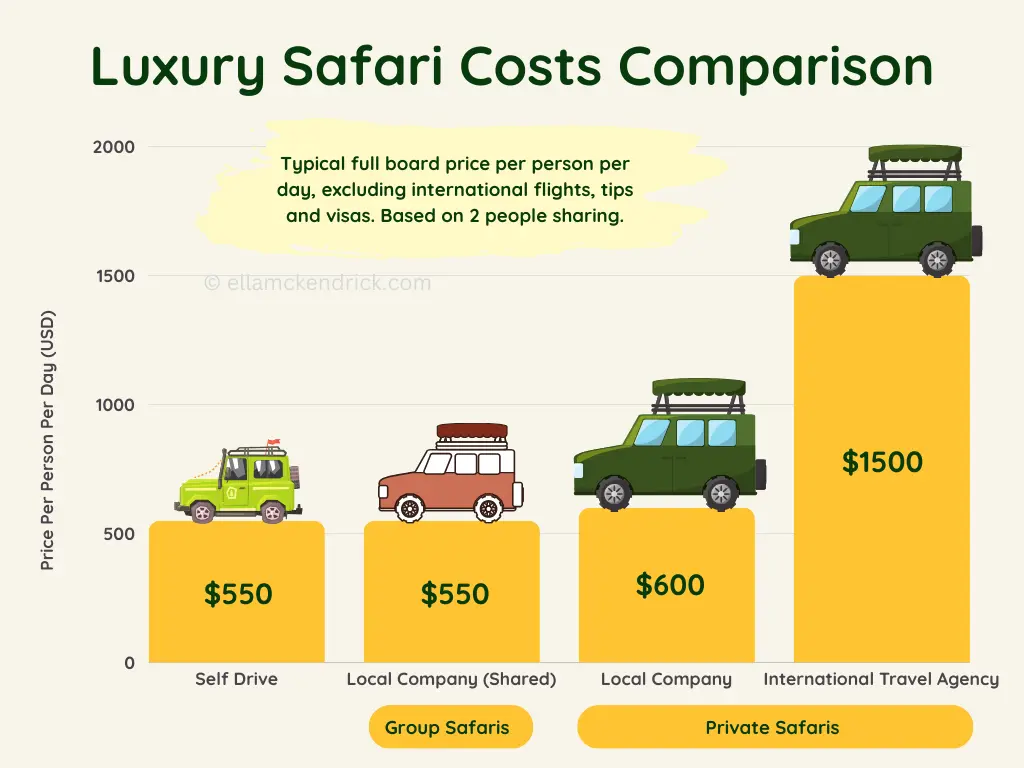
Notes on luxury safari costs
- The self drive option is cheaper than the local supplier because you’re saving on the driver/guide. However, since you’re paying a lot of money anyway you might as well pay a little bit extra for a driver guide to make sure you have the best sightings as well as a more relaxing experience.
- The international travel agent / safari company price is higher than the local safari company because you’re paying for their overheads and profit on top of the local company who does the safari. Luxury safaris is where the international companies really make most of their money so they will have a bigger differential on this level as often the people spending this much money are not very price sensitive and may perceive higher price to equal higher value.
Recommended Booking Options For Luxury Kenya Safaris
Private Safari
Most popular & best experience – typical prices for this itinerary start from $600 per person per day.
Visit safarisbyella.com for free quotes from trustworthy local tour companies I use to book my own trips.

Factors Affecting Your Kenya Safari Cost
When you receive a number of safari quotes, you might end up wondering why one quote is coming out higher than another quote and which is actually the best value. I’ll attempt to answer that question below.
Below are the factors in order of which will have the biggest impact on your safari cost.
Whilst this order is correct for most cases, one notable exception is for solo travellers on private safaris. For solo travellers, group size will move up to position 2 in terms of factors affecting your safari cost for budget safaris or position 3 for mid-range because you’re shouldering all of the fixed costs (vehicle, guide etc).
1. Type of Safari Company
There are four different ways you can organise a Kenya safari Itinerary: self drive (DIY), hotel provided safaris, local safari company and international safari company (located in US, UK etc).
I’ll go into each of these options below and their effect on costs.
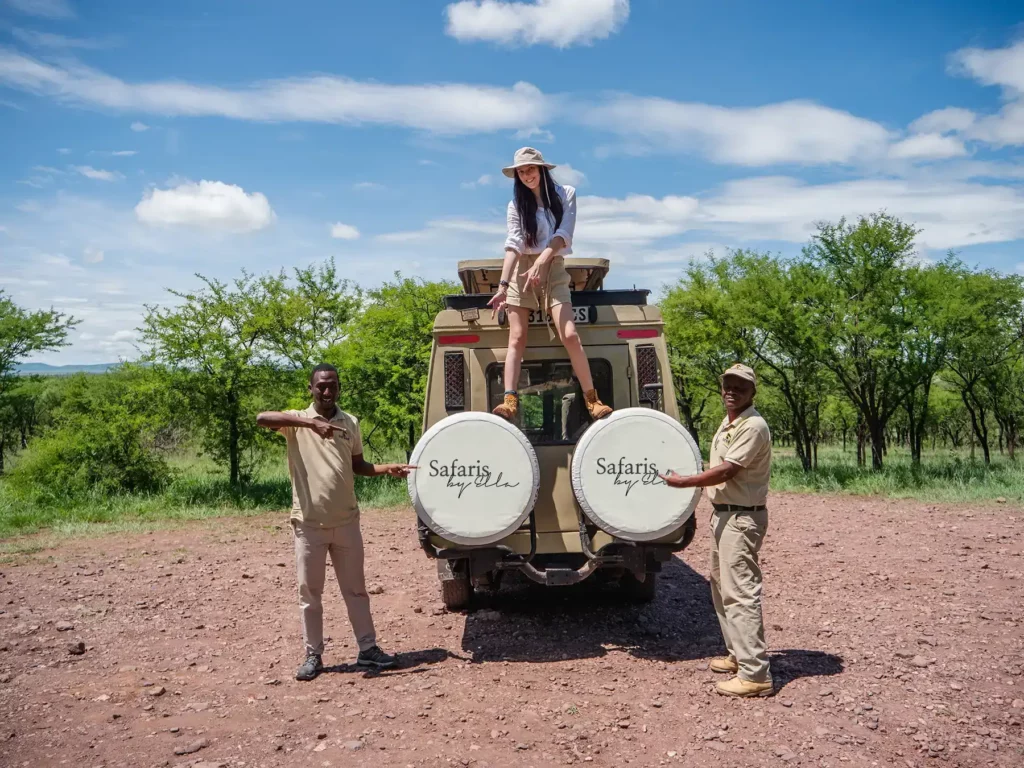
Self Drive (DIY) Costs
June 2024 Update: The Narok County government, which oversees the Masai Mara, issued a statement banning self-driving cars in the Masai Mara to protect the ecosystem.
Only licensed drivers and tour operators will be allowed to enter the Maasai Mara National Reserve. As a self-driver in a rental vehicle you will not be allowed to drive the vehicle. You can read further discussion on this topic on the 4×4 community forum.
To visit the Masai Mara you would need to use a licensed safari company who will provide a professional driver guide.
Self drive safaris seem to attract those who like the added sense of adventure which comes from being self-reliant and doing it all yourself as you navigate through foreign lands.
Some people on the other hand opt for self drive in an attempt to reduce safari costs.
I’m no stranger to self drive and In 2017, I embarked on a self-drive adventure across Namibia and had an incredible experience. However, I would not recommend self driving in Kenya for three reasons:
- Whilst Kenya is marginally better for self-drive safaris than Tanzania due to the slightly more flexible park vehicle entry requirements, it’s still not really geared up for self-drivers. Most people use a safari company in Kenya and this is how the country is geared up.
- There are more hazards in my experience for self-drivers in Kenya vs Namibia – whether that’s going through a flooded path only to find yourself stuck in a large hidden pothole under the water to being stuck in a remote road with a flat tyre caused by the bumpy roads. The experienced driver guides know how to handle these situations but as a self-driver, you can quickly find yourself out of your depth and wasting valuable safari time and unnecessary stress.
- Last but probably the most important reason is that experienced guides have an invaluable knowledge of the parks and access to phone and radio communication with other guides. This leads to incredible once in a lifetime sightings. When in Namibia, safari was only a tiny part of my trip but in Kenya, safari was my main focus so having a good guide was essential. For me it’s a no-brainer to spend a small amount more for a safari company with experienced guides to get the most from my safari and have a more relaxing time.
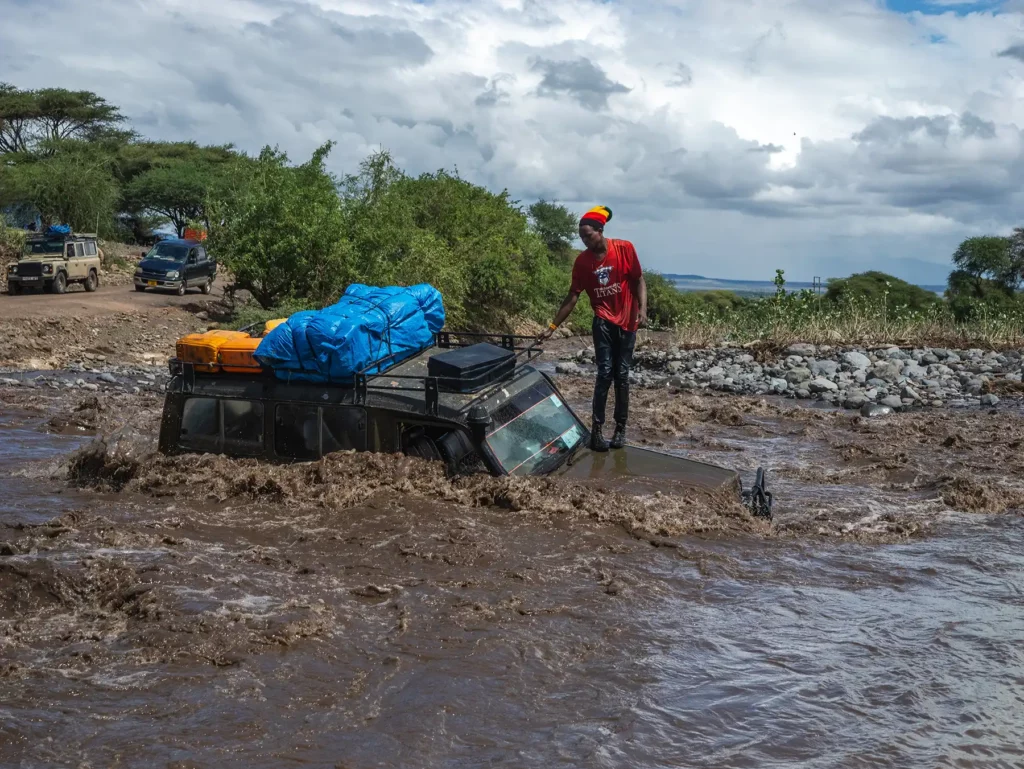
The way I see it is, after paying for flights, accommodation, park fees etc, why would I want to miss out on all the amazing wildlife sightings a good guide can offer, just to save a few dollars by driving myself?
The below chart gives you a rough idea of where your money goes when you opt for DIY self-drive Kenya safari.
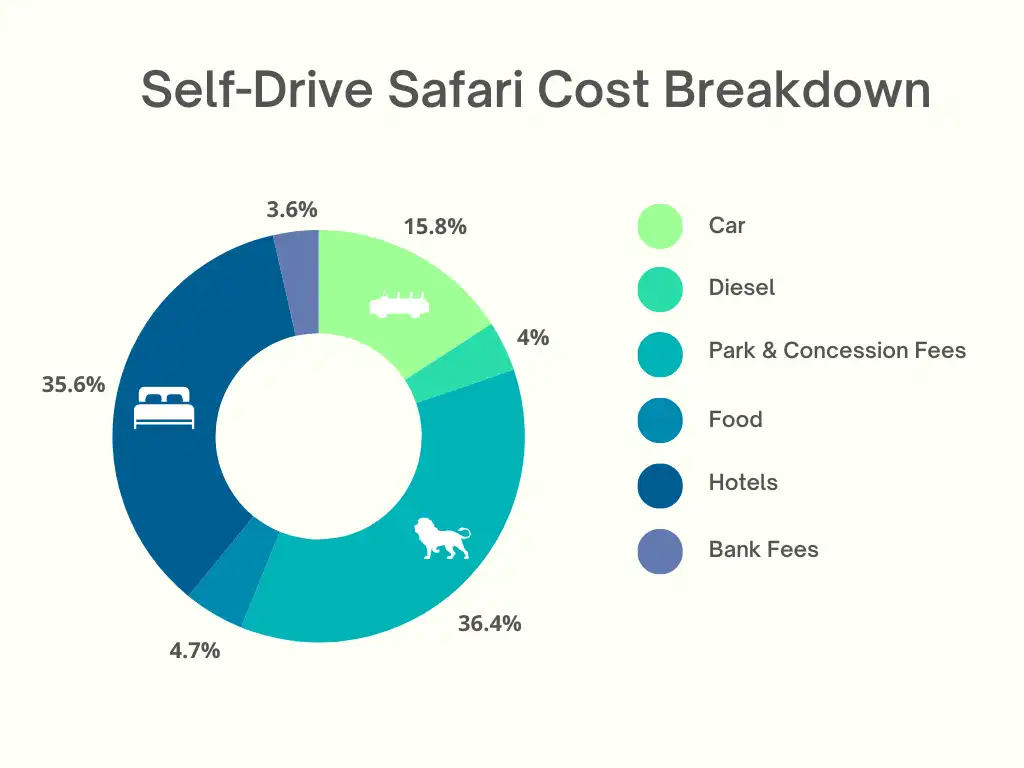
How to Book a DIY Self-Drive Tanzania Safari
- Option 1: Comparison sites which provide multiple quotes from verified suppliers such as Safaris By Ella. Make sure to write you want to self drive in the notes when requesting a quote. (This is a hybrid approach where you’ll drive yourself but they will arrange everything)
- Option 2: Research and book all elements of the trip yourself using Google and online travel agents.
Join the rapidly growing tribe of over 1,000 travellers who’ve booked their dream safari using my insider tips and recommendations. Get your free quotes and my top tips and recommendations now.
Local Kenya Safari Company Costs
I’ve found that the best value-for-money safaris in Kenya are achieved by using a good local safari company. The right safari company will be invaluable in saving you time and money through their local knowledge and on-the-ground networks.
For example, the best local safari companies will have inside knowledge of the wildlife viewing in each of the national parks at any given time, the current position of the great wildebeest migration and work with you to plan an itinerary to put you in the right place at the right time to view the sightings which matter to you.
I’ve found that not all local safari companies are created equally and the sweet spot has been finding the up-and-coming companies, run by locals who are committed to making sure every safari runs perfectly.
Some of the older and larger local companies start to rest on their laurels and standards start to slip. My on-the-ground research highlighted that some of these companies have over-expanded and started to hire inexperienced guides and use older trucks which then break down.
Conversely, I’ve found some companies are just a little too small to the point where they can quickly get over-stretched which can lead to standards dropping.
This is why I always look for companies which are small enough to care about every single client but big enough to deliver a consistent high service level. In Kenya I always try to use companies run by locals to make sure I’m supporting the local communities as much as possible.
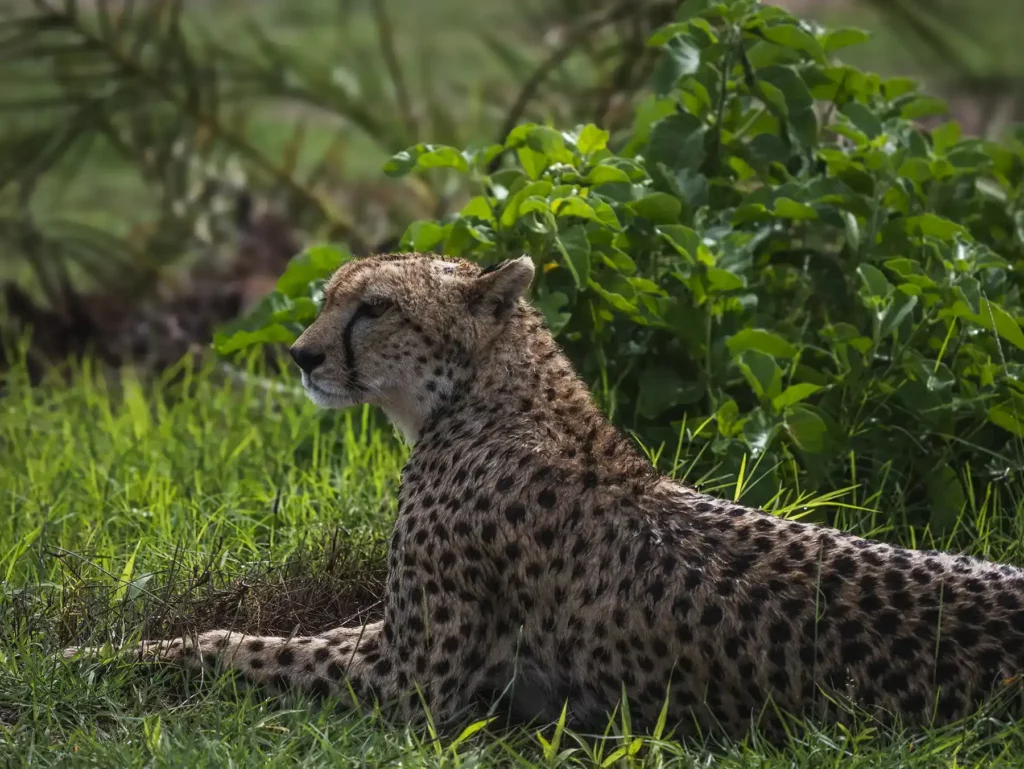
Due to their low overheads, many small local tour operators only include a small 10-15% margin in their quotes which goes towards their wages and limited business overheads leaving them with 3-5% profit.
With accommodation, most local tour operators have special arrangements with the hotels whereby they receive lower rates than it would be possible for you or I to achieve when booking directly. This means that even after they safari company adds their small profit margin, the price of the hotel is similar and in some cases less than booking direct.
I’ve noticed that in the case of some activities such as hot air balloon safaris which are already quite expensive, local tour operators don’t actually make any profit on these and simply arrange them for guests as a gesture of goodwill.

The below chart gives you a rough idea of where your money goes when you book your safari with a local safari company

You’ll notice that accommodation and park fees are the two biggest costs, making up over 50% of total safari costs. Park fees go towards the upkeep of the parks and conservation – they are important as it’s very expensive to protect the wildlife from human threats such as poaching.
According to my calculations and insider information, only approx 3% of the total safari costs goes to the safari company as profit after deducting their overheads. Although this seems very low, you have to remember that the cost of living is lower in Kenya vs the West and safaris tend to be quite high value (to which the 3% relates), so this is how they are able to operate on such thin margins. However, the plus side as a buyer is that, unlike with International operators, you’re not having to fund expensive offices and high staff costs etc.
The chart above is calculated based on a mid-range safari. For budget safaris, accommodation costs will make up a slightly lower percentage of costs and with luxury safaris, the accommodation costs will often be in excess of 50% of total costs.
How to Book with the Best Local Safari Companies
- Comparison sites which provide multiple quotes from verified suppliers such as Safaris By Ella
Join the rapidly growing tribe of over 1,000 travellers who’ve booked their dream safari using my insider tips and recommendations.
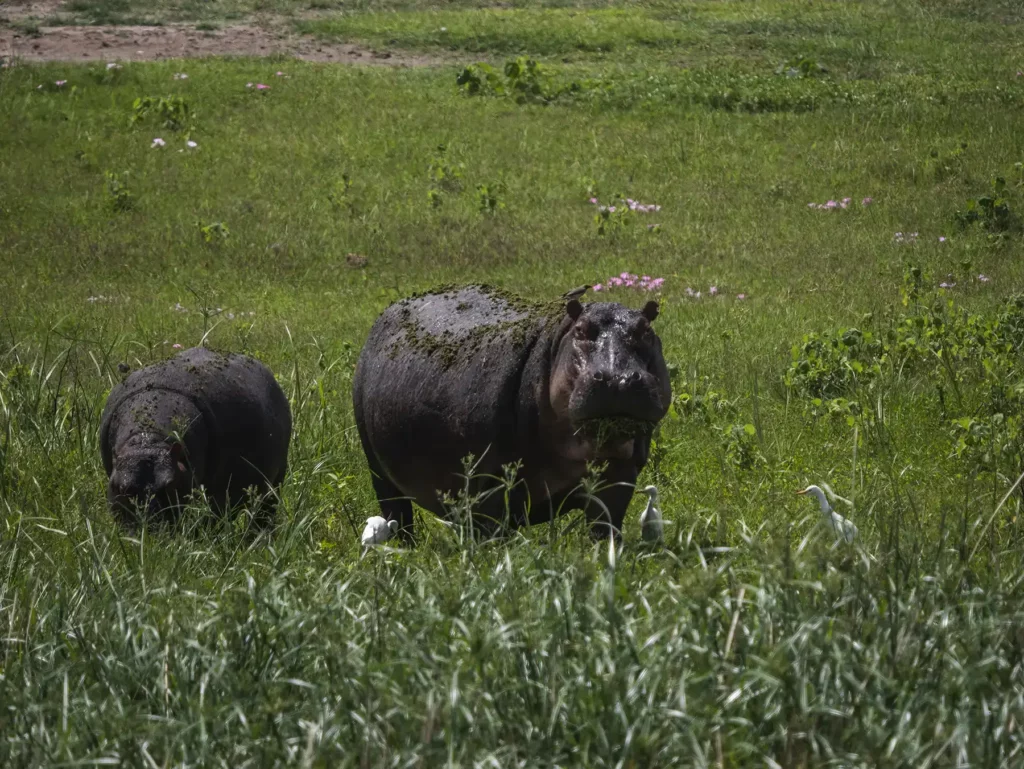
International travel agent / safari company (US, UK etc.)
After doing some research and chatting to local tour operators, I soon discovered that international travel agents and safari companies from the US, UK etc. subcontract their safaris out to local safari companies. The logo stickers on the safari trucks are switched out for those of the international company for the period of the safari.
Whilst there is absolutely nothing wrong with this practice, it does mean you are paying more when booking through a safari company based in your own country. The reason being that you are paying for the overheads (offices, staff, marketing etc.) and profits for the company in your local country as well as the overheads and profits of the local safari company who conducts the safari.
The extra amount you pay on a like-for-like basis when booking through an International operator ranges greatly from 20% to a massive 300% more with some high-end luxury safaris.
Aside from the cost difference, there are a few other pros and cons when booking this way. Aside from the extra cost, the other common complaint is communication issues. Special requests often get lost in communication between your sales rep and the driver / guide who will actually be delivering your safari. Likewise on-the-ground updates and local knowledge are not always passed up accurately from the local safari company through to the International company and through to you at the point of planning your itinerary.
On the positive side, international safari companies in the US / UK etc. do provide a number of key benefits. Unlike many local companies, they can book international flights for you, they may offer a greater level of deposit protection and they are experienced with high-end requests such as chartering private jets.

It’s been my experience that overseas travel agents who focus on safaris tend to cater for luxury and luxury plus safaris. You typically need to be spending at least $15,000 USD to receive a reasonable level of service from them and budgets of $50,000+ are required to receive their full attention and service levels. Costs can reach in excess of $100,000.
As I mentioned earlier, a key benefit for booking though an international tour company can be the level of purchase protection they offer should things go wrong or if they go bust before your trip.
I’ll cover some protections for companies in the UK and US. However, other countries have their own versions of these protections too.
In the UK you will typically be covered by the Package Travel Regulations, a set of rules that those selling and booking package holidays and linked travel arrangements must follow. In theory this provides you with protection should the company go bust after you’ve paid them money but before your trip.
As far as I understand it, compliance with the funds protection part of these regulations by the company is either achieved by the company posting a bond with their bank (effectively cash reserved to one side) or using a third party company to hold the cash only for use in booking your trip. I’ve been told by insiders that when COVID hit, the bonds method didn’t actually work (some companies which went bust didn’t have enough money in their bond to cover the all trips) due to the scale of the event but I think outside of extreme once in a lifetime events, it’s a good things and does generally work as intended.
Also in the UK, if the travel agent books international flights as part of your package, you will be covered by the ATOL scheme. ATOL stands for Air Travel Organisers’ Licensing (ATOL) is a United Kingdom Civil Aviation Authority (CAA) scheme. Unlike the Package Travel Regulations, the ATOL scheme has a central fund held by the scheme itself, which pays out when required. As far as I’m aware the ATOL scheme passed the COVID stress test and paid out as it should.
In America there are schemes such as the Airline Passenger Protection Act and the Federal Aviation Administration’s consumer protection rules which apply when booking through a local travel agent in the US.
It’s worth noting that, In my experience, it’s possible to achieve a satisfactory level of protection yourself when booking directly with local tour operators. Here are my top tips:
Use your credit card when paying the deposit payment as credit cards typically offer purchase protection. In the UK it’s called Section 75 and you can read how this applies to specific cards such as Visa UK. Check your home country’s credit cards protection terms and conditions for your specific situation. Secondly, purchasing good comprehensive travel insurance with travel interruption cover or similar can provide peace of mind.
The below chart gives you a rough idea of where your money goes when you opt to book your safari with an international US / UK etc. safari company.

Compared to the local tour operator costs breakdown, you will notice additional costs on the international travel agent / safari company breakdown above. I’ve explained these extra safari costs below:
Safari company overheads and profits – this is the overheads and and profits of the local safari company to whom the international travel agent / safari company who you booked with will then outsource the actual the safari to.
Travel agent overheads & profit – This is the overheads and profit of the International travel agent/ safari company who sold you the safari and which they will add to the safari costs. I’ve added 25% as this is the typical starting markup used, but with high-end international safari companies, this can be as much as 300%.
How to Book Your Safari with an International Travel Agent / Safari Company
- Comparison sites which provide multiple quotes from verified suppliers such as Safaris By Ella. When you select a luxury budget on the quote request, you will receive a quote from my recommended International safari company as well as my recommended local companies for comparison.
Join the rapidly growing tribe of over 1,000 travellers who’ve booked their dream safari using my insider tips and recommendations.
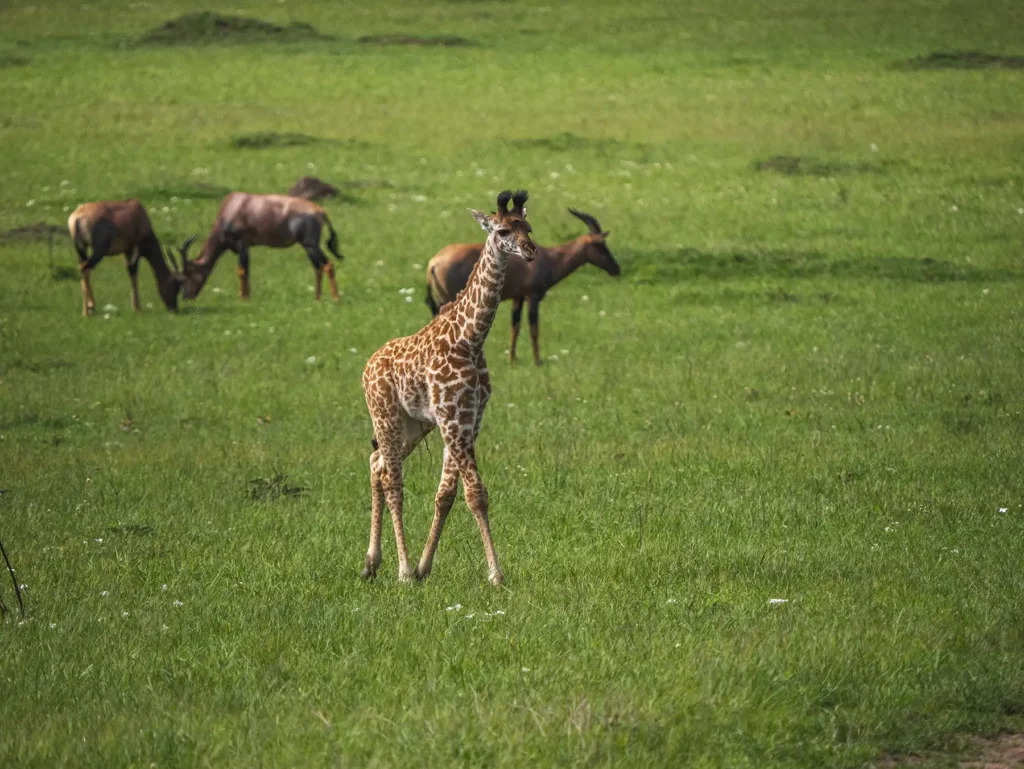
Hotel Provides Safaris Costs
Some of the luxury + hotels in Kenya which are located within the national parks offer safaris to guests using their own safari trucks and guides. Usually these will be shared safaris with other guests.
Whilst these safaris tend to be very expensive as the hotels charge a premium price for them, they might suit you if you are planning to spend most of your time in the hotel with only the occasional safari and you don’t mind sharing with other guests.
Typically for this option you would fly directly to and from the hotel using a small propeller plane.
How to Book a Hotel-Provided Safari
- Option 1: My recommended tour operators on Safaris By Ella can arrange hotels and air or road transport to and from the hotels. If you opt for the more cost-effective road transport, since they have driven you to the hotel, you might find it cheaper to use the safari company for safaris rather than using the hotel-provided safaris.
- Option 2: Check with your chosen accommodation whether they provide this service and the booking requirements.
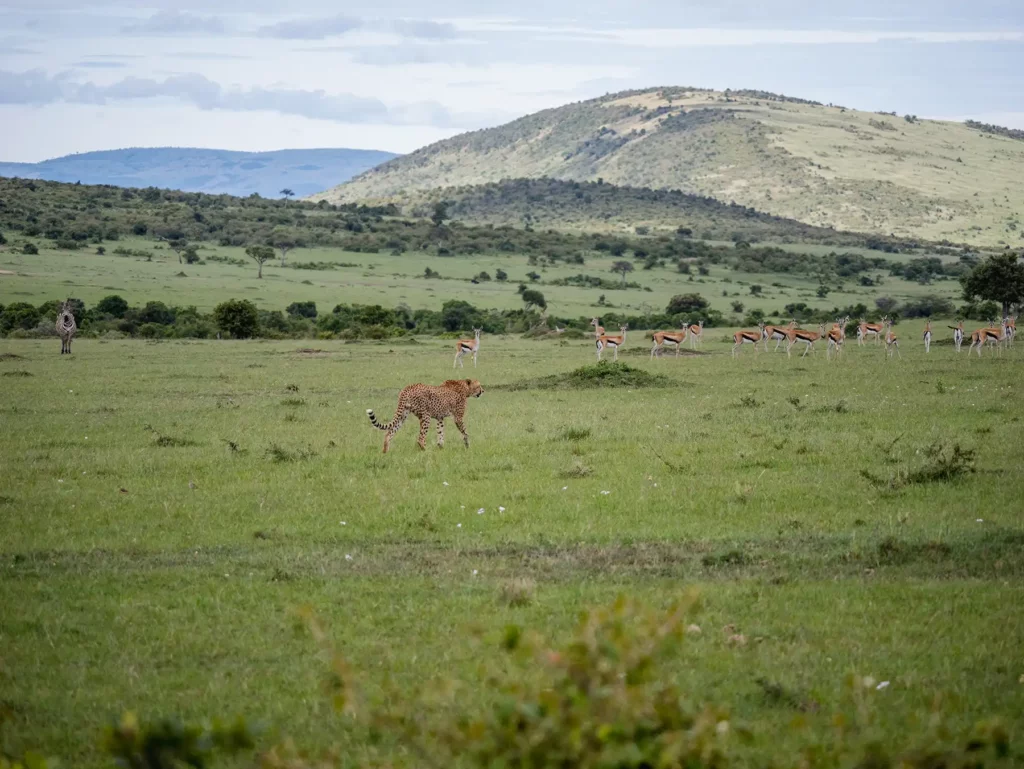
2. Safari Accommodation Costs
Accommodation typically makes up around 30% of your total safari cost when working with a local safari company, which equates to around 1/3rd of the total safari cost.
The level of accommodation is the main factor which accounts for the differences in cost between a budget, mid-range and luxury safari.
Kenya safari lodges and tented camps usually charge on a full board basis, per person rather than per room. However, two people sharing a room will be a lower cost than having a room to yourself.
You will often eat breakfast in the form of a buffet before your safari. Your guide will arrange either a cold lunchbox or hot meal from the accommodation which you will normally eat on your safari, although you can come back to the accommodation for lunch if you wish. I tend to eat on safari as some parks such as the Masai Mara charge for each entry so it makes sense to eat in the park. Finally, you’ll have a hot dinner at the accommodation – depending on the accommodation this might be a buffet or cooked to order from a menu.
Accommodation located in the national parks are more expensive due to the inclusion of overnight park fees in the costs as well as higher rent and running costs.
I have found that there are good accommodation options right on the edge of the Masai Mara. They benefit from fantastic views over the national park from the lodge and only a 5 minute drive to the gates for your safari, whist being a lower cost vs the accommodation inside the park.
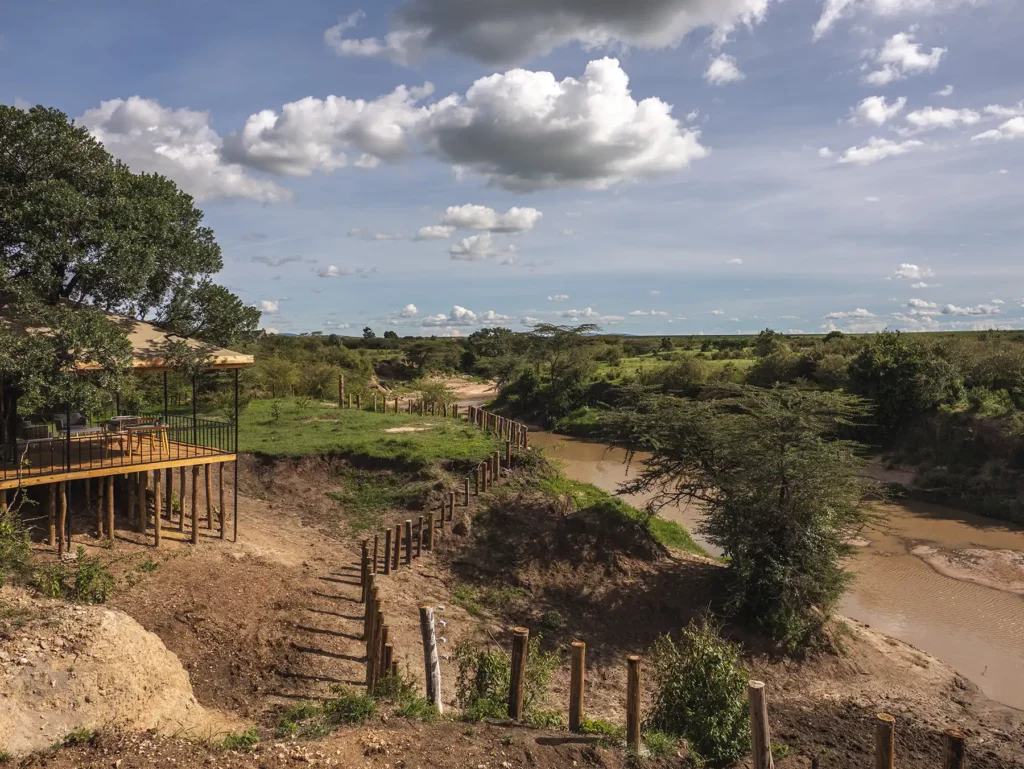
Table showing typical prices per person per night on a full board basis in peak season
| Location | Budget | Mid-Range | Luxury |
|---|---|---|---|
| Nairobi | $30 | $50 | $100 |
| Amboseli National Park | $50 | $80 | $200 |
| Masai Mara (Outside Park) | $70 | $300 | $500 |
| Masai Mara (Inside Park) | $150 | $400 | $800 |
Below I’ll provide guidance on what to expect for each level of accommodation. You can jump to the each of the sections using the links below:
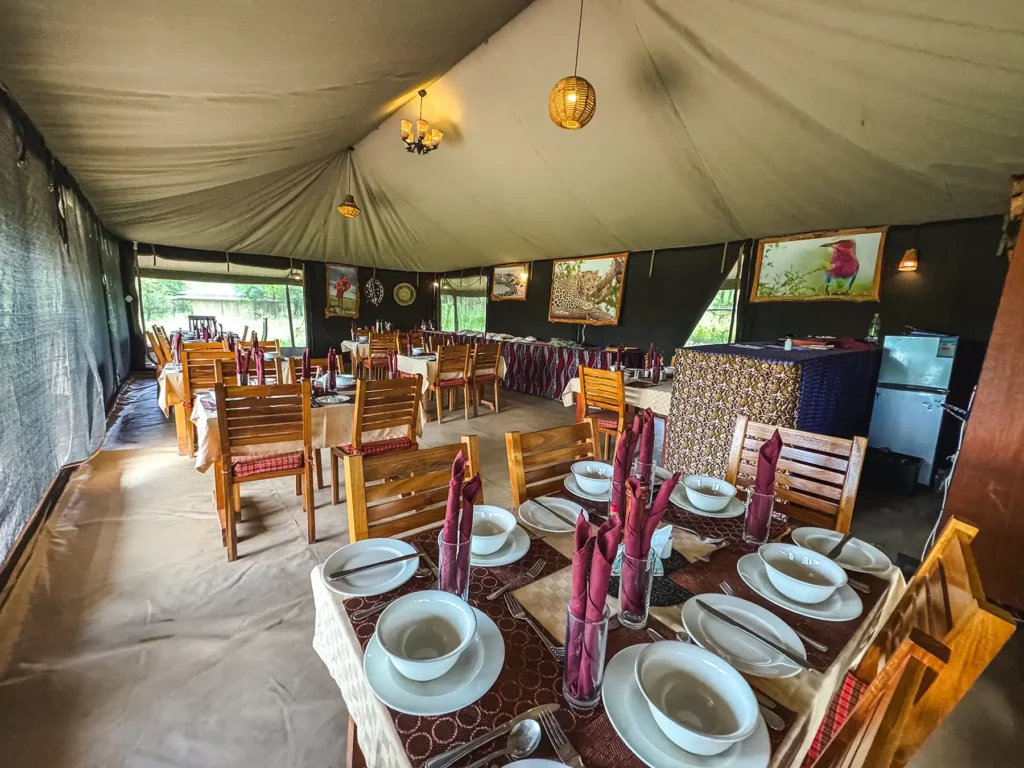
Budget Kenya Accommodation Costs
($30-$100 per person per night)
Budget accommodation includes tents (camping), tented camps, lodges and hotels and spans quite a wide range.
In some cases you might find private bathrooms and in others shared communal bathrooms. Bathrooms will usually be western style.
Budget accommodation is typically located outside of the national parks with the exception of some campsites. In Kenya, most of the wildlife viewing areas in the parks are quite accessible from the entrance gates so this doesn’t really pose a problem. By contrast, in the Serengeti in Tanzania, you really need to stay inside the park due to the scale of the park as it can take hours just to get to the closest wildlife viewing areas.
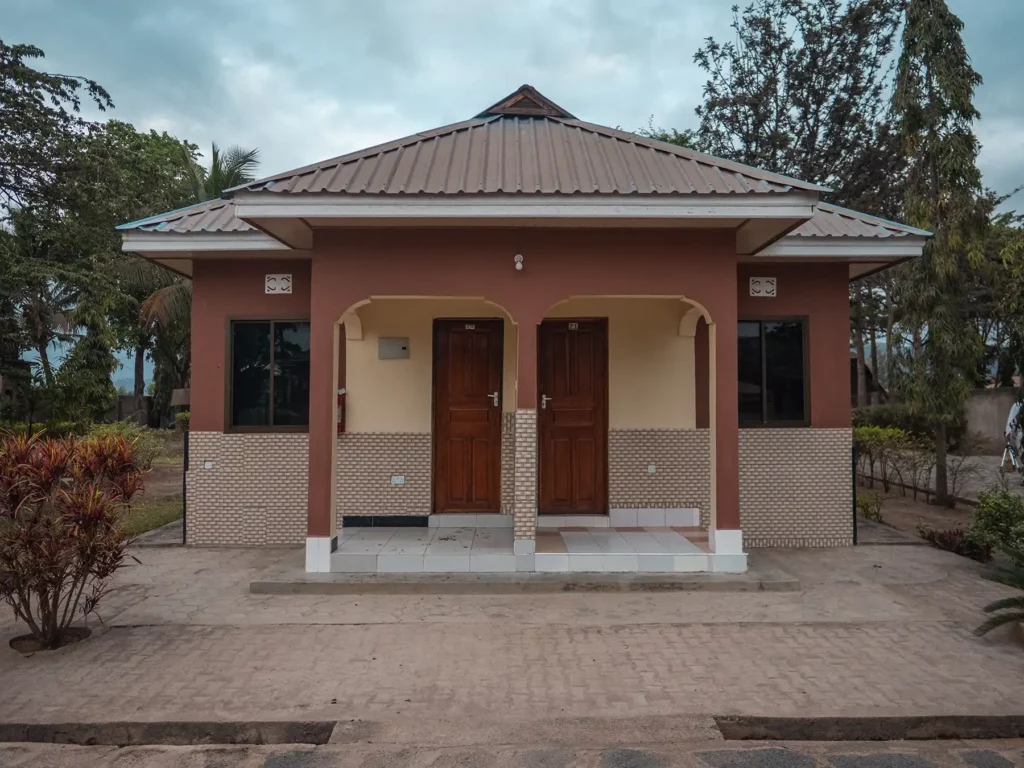
Food will generally be in the form of a buffet and whilst I’ve generally not had any issues with getting an upset stomach at safari accommodation, it’s worth noting the food will usually be higher quality in mid-range and luxury accommodation. The one time I did get a funny tummy was at a budget accommodation buffet. If you have a very sensitive stomach either be selective in your food choices, selecting low risk and freshly cooked food, or opt for a higher accommodation level.

Although I have stayed at some great (and some not-so great) budget accommodations in the past, I tend to pay a little bit extra for mid-range or higher these days. I’m already paying quite a bit for the safari, so I figure I might as well spend a little bit more to have comfortable accommodation. Safaris can be quite physically demanding when I choose to get up at 6am and safari for the whole day so I find it quite important to come back to a comfortable base to eat and rest before another full-on day.
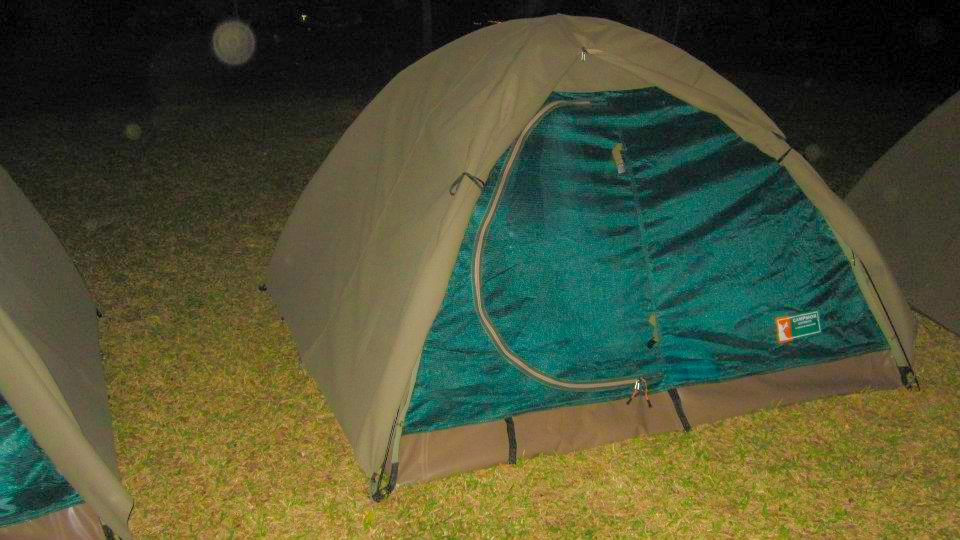
Mid-Range Kenya Accommodation Costs
($50-$400 per person per night)
Mid-range accommodation is the most popular type of accommodation for Kenya safaris as it provides great comfort whilst offering good value for money compared to luxury which can get expensive.
Mid-range accommodation usually always comes with a private bathroom.
There are three key types of mid-range accommodation: tented camps, lodges and hotels. Whilst hotels are common in the cities, you’ll usually find tented camps and lodges nearer the national parks. Inside the parks, tented camps are the most common type of mid-range accommodation.
Tented camps are very different from budget camping and are usually large permanent tents with normal beds, western private bathrooms and may include sofas and other luxuries. The benefit of a tented camp vs a lodge is that it gives you more of a connection with nature as you can hear the sounds of the animals in the night which is quite an exciting experience. The camps are very safe with guards who patrol the camps during the night.

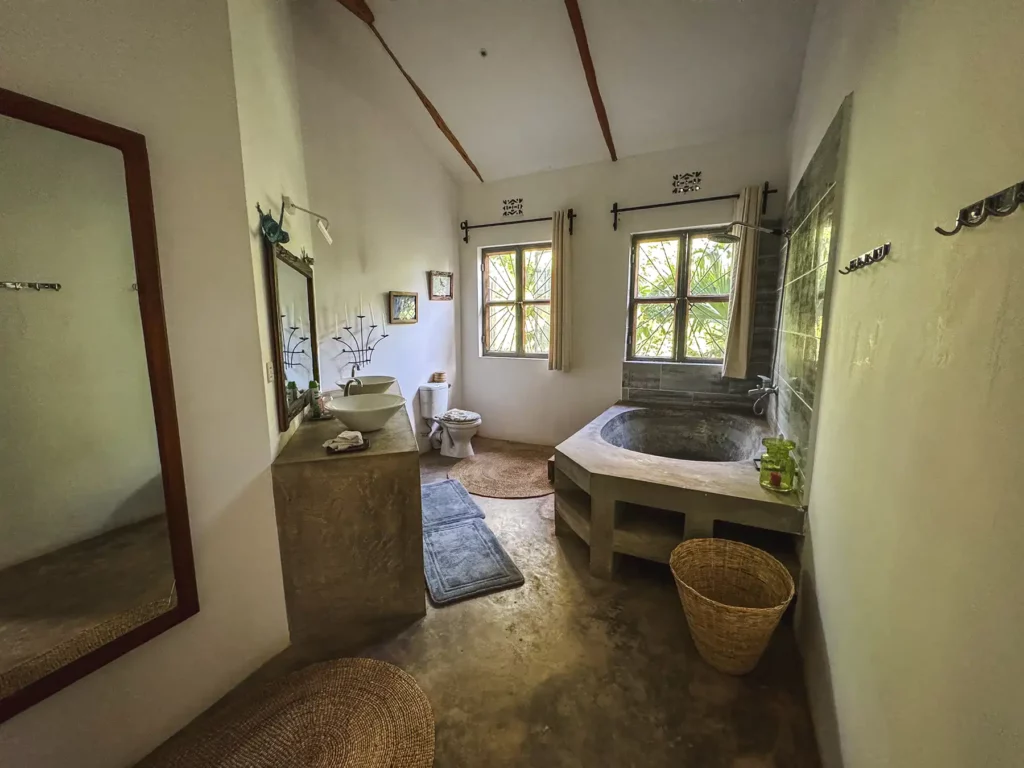
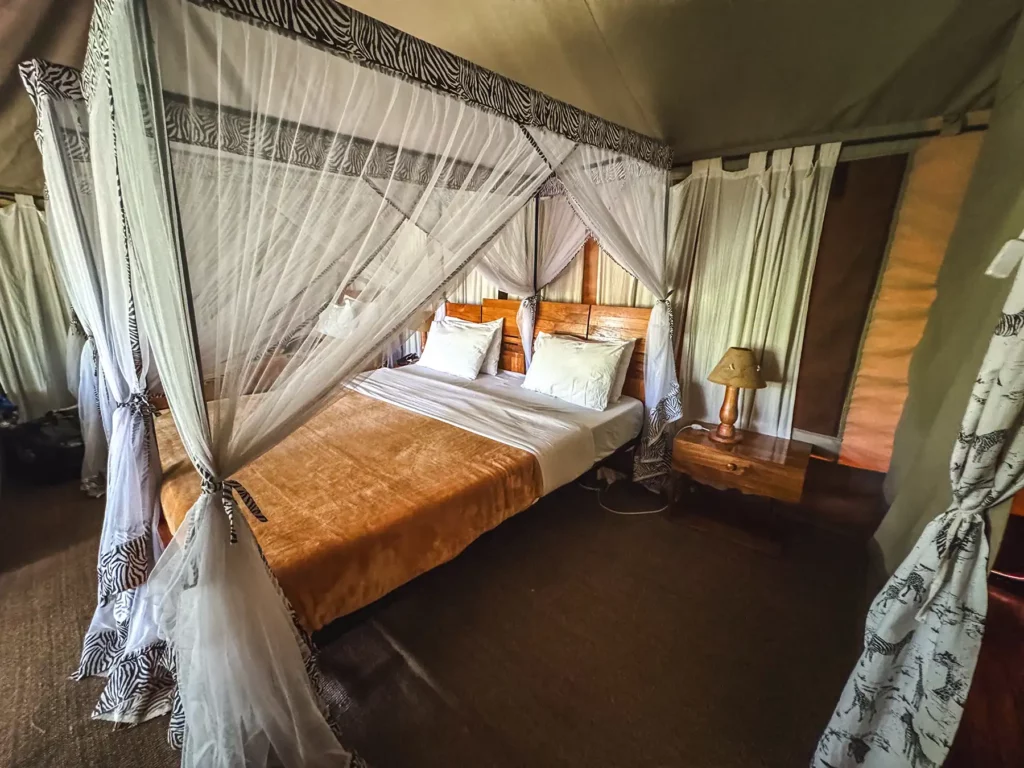
This particular camp used to have bucket showers, where they load up your shower with water from outside when you want a shower, but had recently upgraded to hot and cold running water.
Luxury and Luxury+ Kenya Accommodation Costs
($100 – $3,000 or more per person per night)
One of the quintessential luxury experiences in Africa is embarking on a safari so it’s no surprise that there is a huge range of luxury accommodation to choose from if you’ve got the cash to splash.
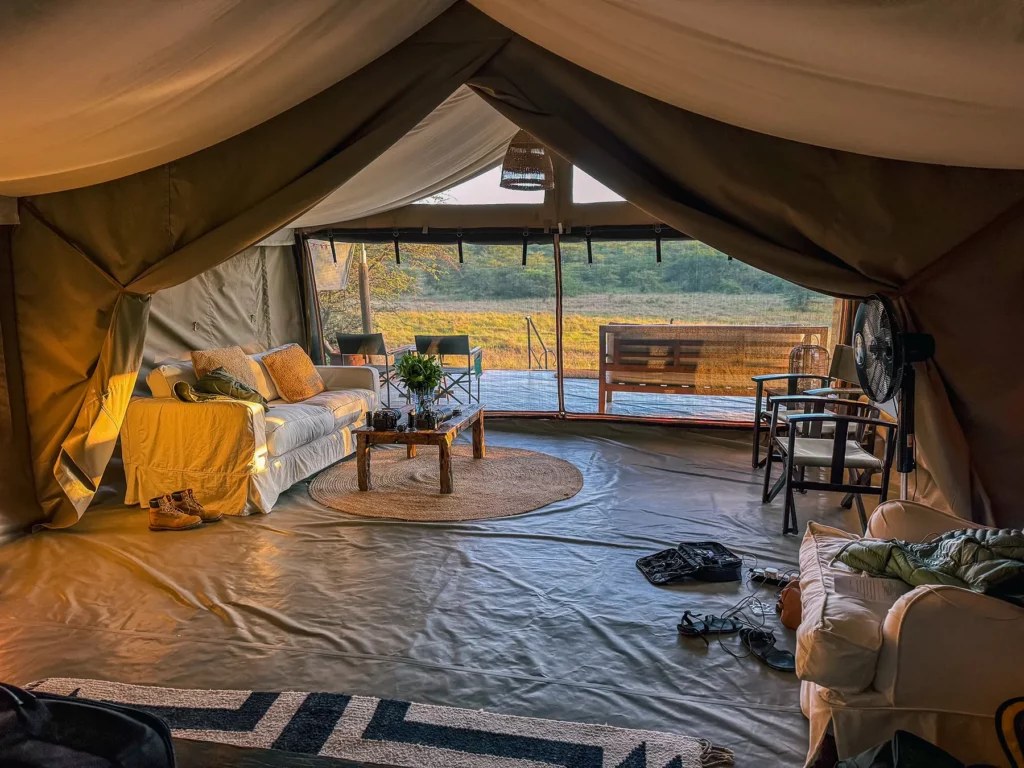
Luxury accommodation spans a huge range of costs from $100 per person per night in Nairobi up to $3,000 or more in some of the most luxurious safari camps in Kenya. Typically full board luxury accommodation comes in around $300 – $500 per person per night in my experience.

Luxury safari accommodation can be in the form of tented camps, lodges or hotels in the cities. Outside the cities luxury accommodation will often but not always be located inside the national parks or bordering conservancies.
With luxury accommodation you can expect large rooms, incredible views and spas, plunge pools and infinity pools.
One of the hallmarks of luxury accommodation is incredible food. The camp pictured above didn’t disappoint. They grew a lot of their own food in their own on-site organic vegetable garden. Food will usually be cooked to order instead of a buffet.
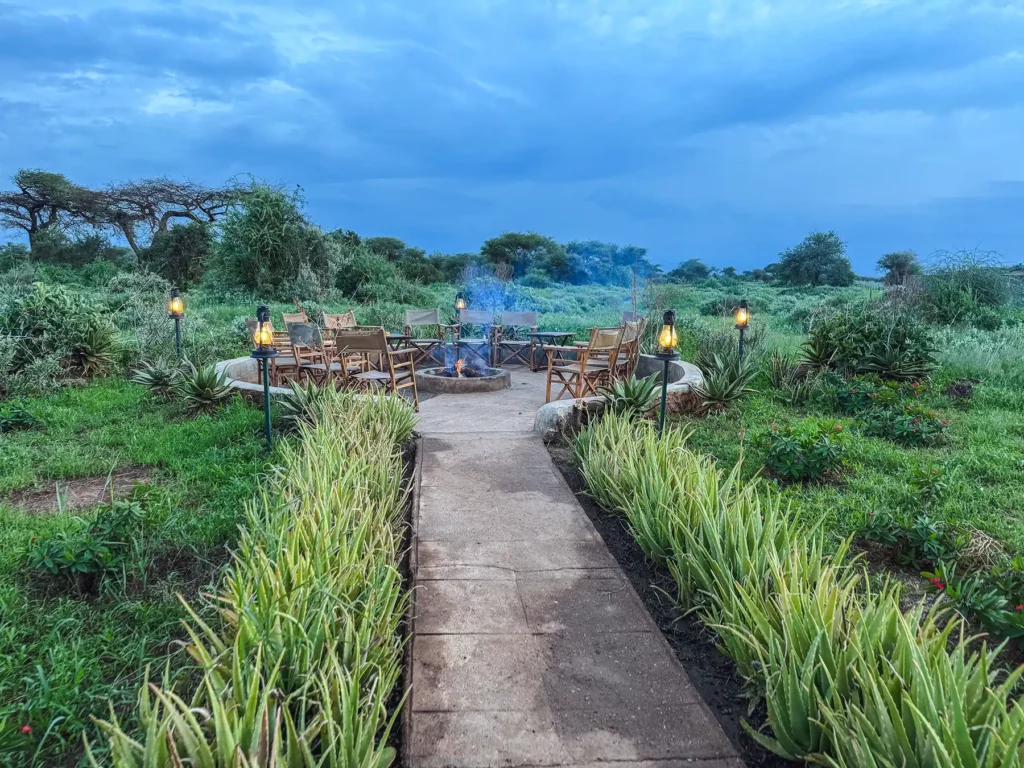
It’s always a very enjoyable experience staying at luxury safari accommodation and I always try to incorporate some luxury accommodation into my trips as a treat. However, it’s worth noting that if, like me, you want to pack in as much time on safari as possible, waking up at 6am and coming back around 6pm, you don’t always get much time to make the most of luxury accommodation.
For longer trips such as a 2 week Tanzania and Kenya itinerary, I’d recommend taking a day or even a morning or afternoon off from safari in order to make the most of your luxury accommodation. Its great to just sit around and relax and rejuvenate with incredible food, drink, views and sounds.
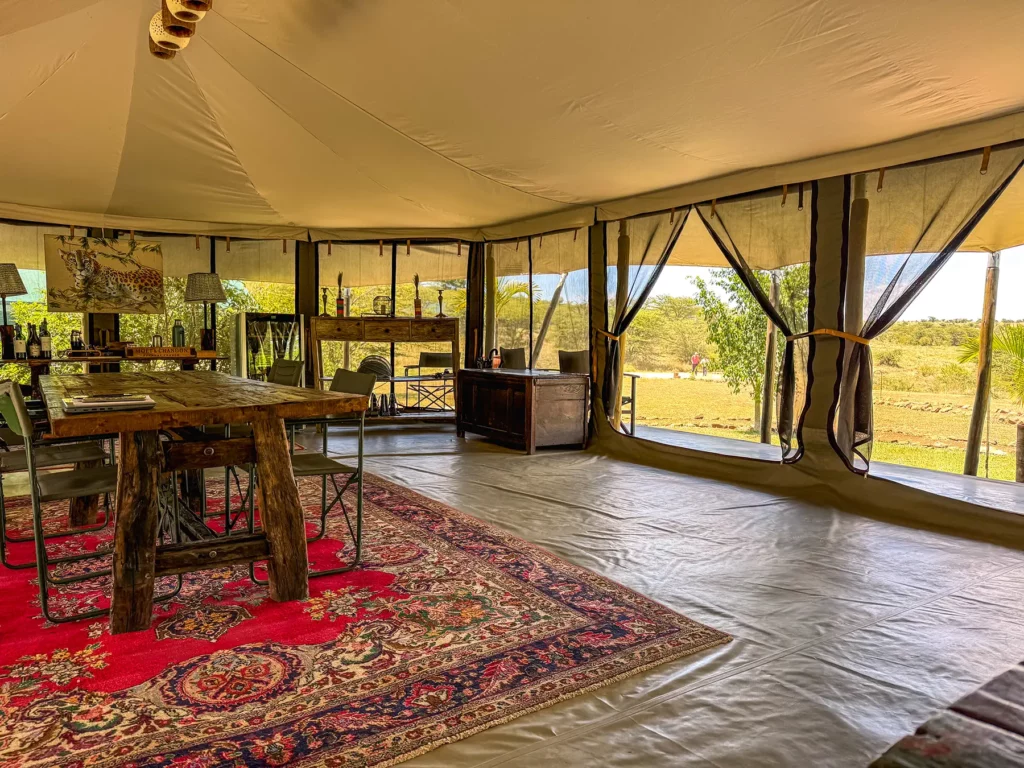
3. Time of Year
The time of year you visit Kenya will affect the cost of your safari. The three seasons in Kenya are dictated by the rains and are the same as those in neighbouring Tanzania.
The low season is March, April and May – this is the lowest cost time to visit. However, you will have to contend at times with heavy downpours and possible flooded roads. The landscape is green and lush which, although very beautiful, can make wildlife spotting a little harder.
The shoulder season covers January & February and also November & December – These months represent a great value time to visit Kenya – whilst there is still some rain it’s more manageable than the low season. January and February are a great time to see baby animals and if you incorporate Tanzania too you can see the wildebeest calving, part of the Great Migration in the Ndutu region on the edge of the Serengeti National Park.
When I visited Kenya in November 2023 it was incredible to see the baby animals as well as the lush, green landscapes. However, I did have a few issues with roads being closed due to flooding from the rains. I’m told it’s not normally such an issue with flooding at the time of year but that El Nino meant the rains were unusually heavy when I visited.
It is worth noting that The January and February shoulder season is quite a bit cheaper than the November and December shoulder season as park fees are higher in the second half of the year. The main cost saving is with accommodation.
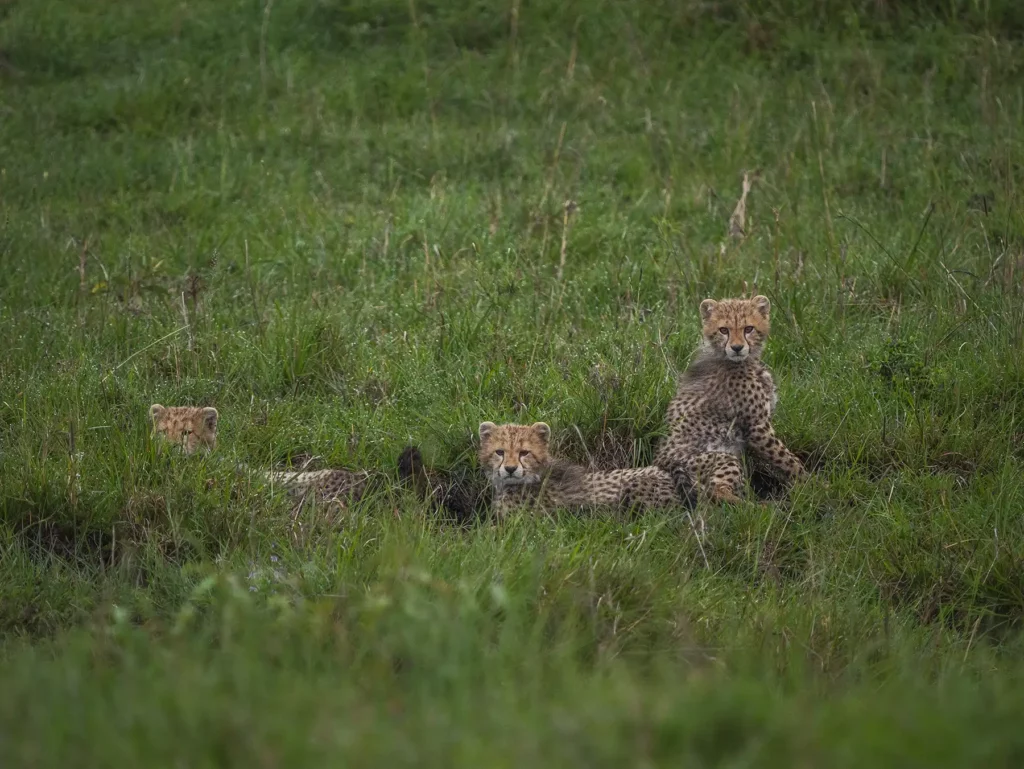
The peak season runs from July to September or October – This is also long as the long dry season and is the most popular and also the most expensive time for a Kenya safari. The lack of water at this time of year means there is little vegetation and animals congregate around water holes making for excellent wildlife viewing. August and September are the two months of the year when you can see the Great Wildebeest Migration in Kenya. During these months you can see the highlight of the Great Migration – the wildebeest Mara River crossing.
For me September is probably the best time to visit Kenya for safari due to the Mara River crossing and optimal wildlife viewing conditions. However, the shoulder season was also incredible as I saw fluffy baby cheetahs frolicking around. I’ve yet to visit Kenya in low season but I’m excited to give that a try soon and I’ll update this article with my low season experience.
The main saving in the shoulder and low seasons is the accommodation costs. Kenya parks fees are also now reduced in the shoulder and low seasons.
Savings are typically 20-30% in low season and 12-15% in shoulder season on a full safari package, with most of the savings coming from accommodation and park fees.
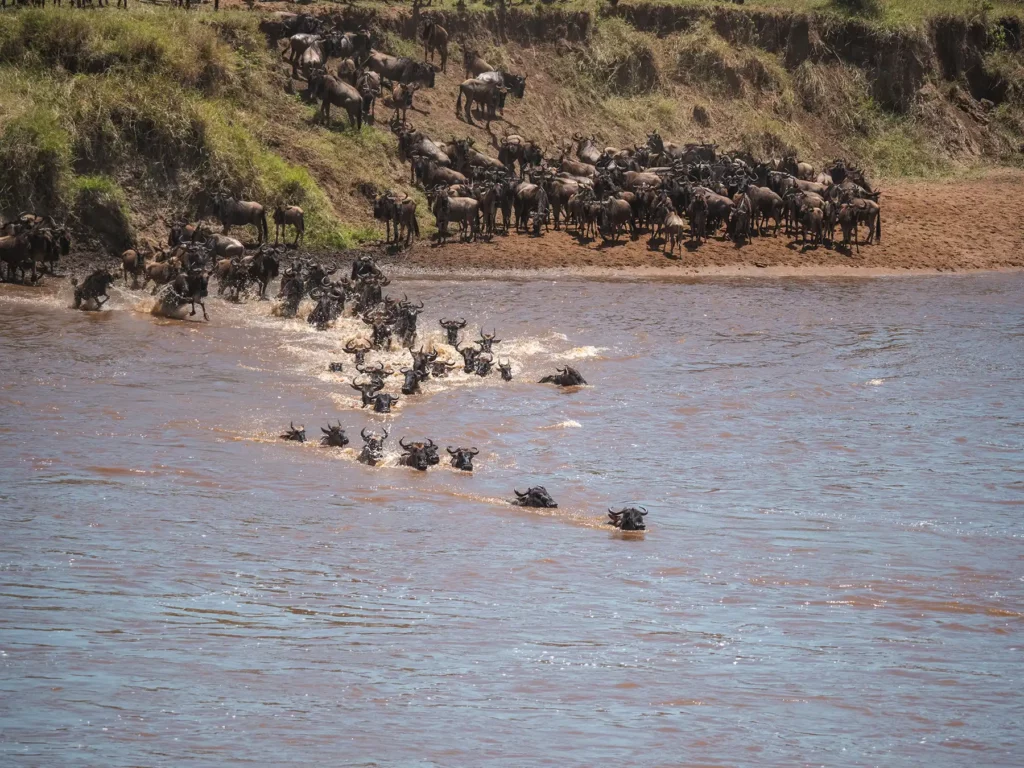
4. How You Travel Between Parks
Your mode of transport between the parks and lodges, such as whether you choose road or air, will affect the cost of your Kenyan safari.
Matatu Minibuses
There are 2-wheel-drive minibus taxis known as Matatus which are a cheap mode of public transport outside of the parks. These are usually overloaded and commonly involved in crashes so best avoided. For airport transfers you are better with a private minibus, luxury taxi or safari truck.
Minibus Safari Truck
The second type of minibus in Kenya is the safari minibuses which are usually 4×4 and used by safari companies to move you between parks as well as inside the parks for game viewing. Whilst not as sturdy as the Toyota Land Cruiser safari vehicles, they are a great option for budget safaris.
The roofs pop up for game viewing.
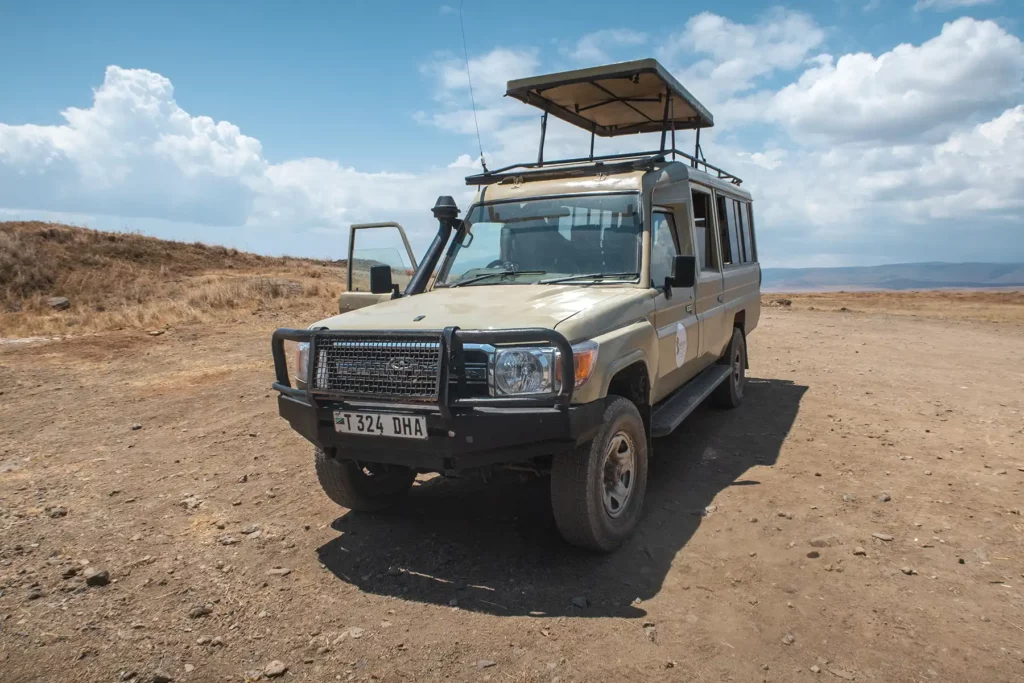
Toyota Land Cruiser Safari Truck
Toyota Land Cruisers are typically used for mid-range and luxury safaris. They are very robust and heavy duty 4×4 vehicles. They are comfortable and kitted out with luxury features such as plug sockets, fridges and sometimes wifi.
They don’t typically have air con as you’ll spend most of your time with the windows open when game viewing so it wouldn’t be particularly useful. They are industrial-grade and get so knocked about on the bumpy roads that they like to keep them as simple as possible so there’s not too much to break.
The roofs pop up for game viewing.
You can request photography trucks which have bigger openings to give more options for lower level shots.
Scheduled & Chartered Propeller Planes
Higher-end luxury safaris may opt for propeller planes to avoid longer driving distances. When flying in and out of camps using planes, the safaris are often called ‘fly in safaris’.
Air transport doesn’t come cheap and prices are typically around $300 per person each way per flight for scheduled flights. You can view Air Kenya’s current flight schedule here.
Private charted flights which can include helicopters as well as planes will provide more flexibility but increase the cost.
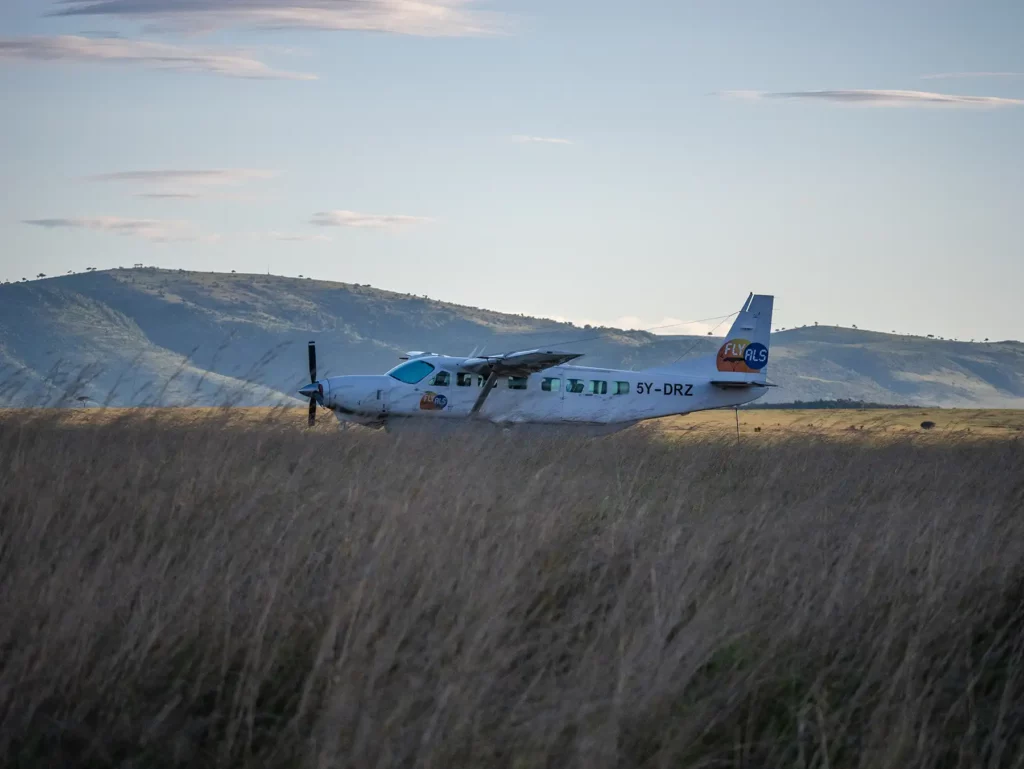
Private Jet
Private jets are popular with VIPs as a method to move around the country but with prices often reaching $100,000 and beyond it’s not for everyone! Depending on the size of the jet, prices range from $2,000-$11,000 per billable hour. Due to the relatively high emissions per passenger of private jets, they are arguably not the most environmentally-friendly way to go on safari.
5. Kenya Safari Park Fees Costs
Based on my breakdown of a typical safari with a local safari company, we can see that park fees make up around 30% of the total safari cost.
Below I’ve provided a list of the current Kenya park fees for a range of popular parks to give you a feel for how the different park rates compare.
Popular Kenya National Parks and Reserves from 1st July 2024 onwards.
| Park Name | Adults (Age 18+) Low Season | Adults (Age 18+) High Season |
|---|---|---|
| Masai Mara National Reserve | $118 | $236 |
| Amboseli National Park Lake Nakuru National Park | $94 | $118 |
| Tsavo East & West National Parks Meru National Park/Aberdares | $41 | $61 |
| Nairobi National Park | $51 | $118 |
| Mount Kenya National Park | $51 | $35 |
Latest prices (excluding Masai Mara) can normally be found on the Kenya Wildlife Service website. However, currently they are only displaying outdated 2023 prices on the website so you would need to access the 2024 prices PDF directly.
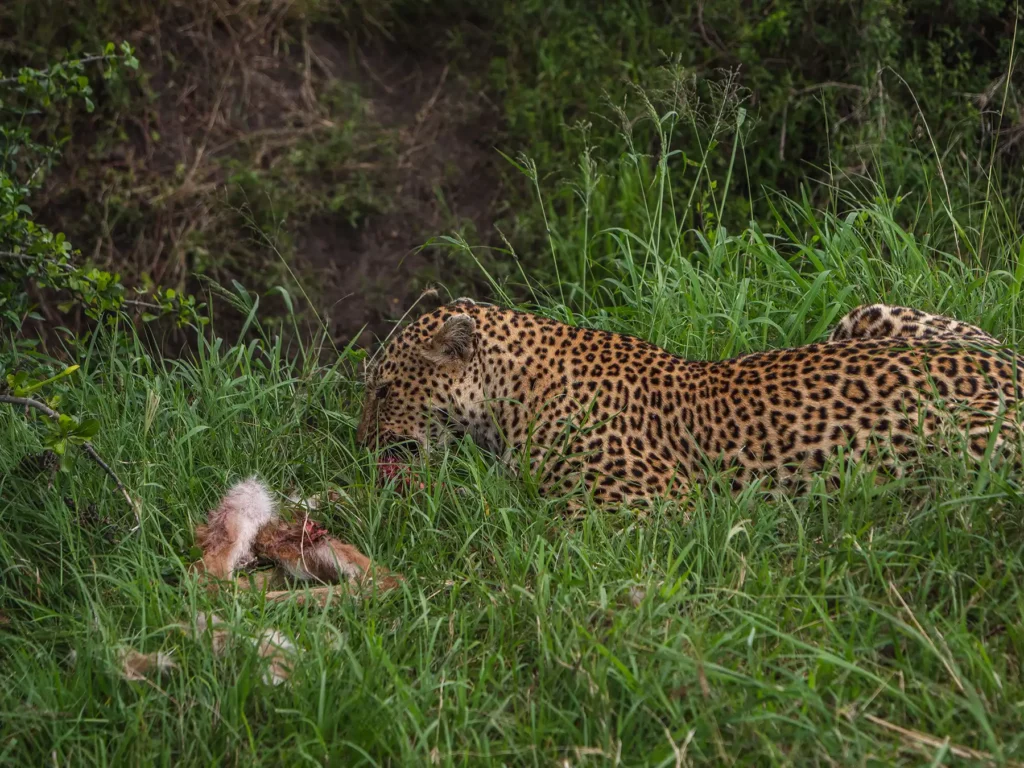
6. Group Size
Safaris for solo travellers are significantly more expensive per person compared to parties of 2 adults sharing a room. Starting prices per adult per day for a private budget safari for a solo traveller is $500 compared to $300 for two people.
The main reason for this difference is that the solo traveller is having to cover all of the fixed costs for the safari vehicle and driver/ guide which can be around $250 – 350 per day, whereas the party of two people only pays 50% of the fixed costs each.
Although hotels usually charge on a per person per night basis due to rates being on a full board basis, there are savings when you are sharing a room vs having a room all to yourself.
For this reason solo travellers with budgets below $500 per day might want to consider a group safari which runs to a fixed schedule and you are sharing the truck with other people.
Although increasing the party size for a private safari up to a maximum of 7 people will continue to decrease the average cost per person, after 2 or 3 people the additional cost savings are fairly nominal.
| Party size | Vehicle contribution per person | Group size savings per person |
| 1 | $250.00 | $0.00 |
| 2 | $125.00 | $125.00 |
| 3 | $83.33 | $41.67 |
| 4 | $62.50 | $20.83 |
| 5 | $50.00 | $12.50 |
| 6 | $41.67 | $8.33 |
| 7 | $35.71 | $5.95 |
There are a few other fixed costs which will be reduced by bigger group sizes. These include:
- Any accommodation changing on a per room basis but this is rare as most accommodation charges per person
- Some cultural tours have a fixed fee regardless of group size
Per person costs which will not be reduced by bigger groups include:
- Most accommodation (beyond 2 people) which is charged on a per person basis
- Park fees
- Flights
- Food
- Activity costs (night drives, horse riding safaris, and experiences such as visiting the Giraffe Centre in Nairobi are all priced per person)
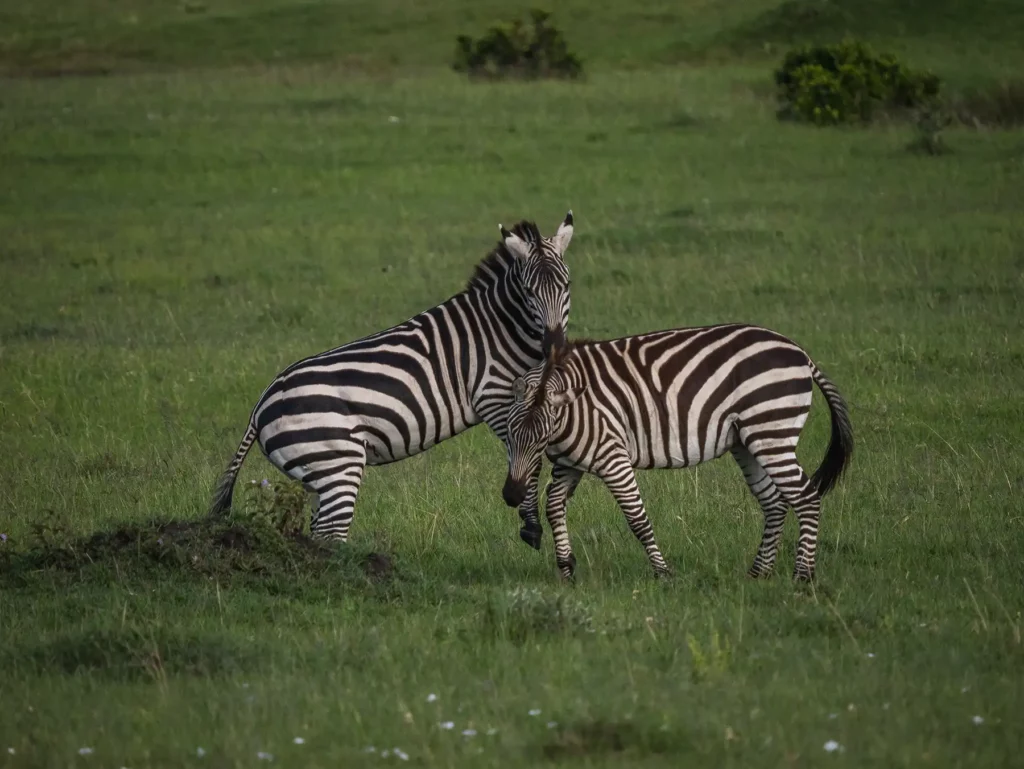

Embark on the Safari of Your Dreams
Save time and ensure an incredible safari experience by getting quotes from my recommended local safari companies
I’m here to make booking your perfect safari quick, easy and risk-free.
Join the rapidly growing tribe of over 1,000 travellers who’ve booked their dream safari using my insider tips and recommendations.

It takes under 60 seconds to fill out the form and in under 48 hours you will receive multiple, no-obligation proposals from my favourite local tour operators with glowing online reviews.
Get your free no-obligation safari quotes and my top safari tips and recommendations
How do Kenya Safari Costs Compare with Other African Safaris?
Safaris in Kenya are some of the the lowest cost safaris in Africa. They are similar in price to Tanzania but lower-cost than other destinations such as South Africa, Botswana, Uganda and Rwanda.
You can see how costs compare across popular African safari destinations below:
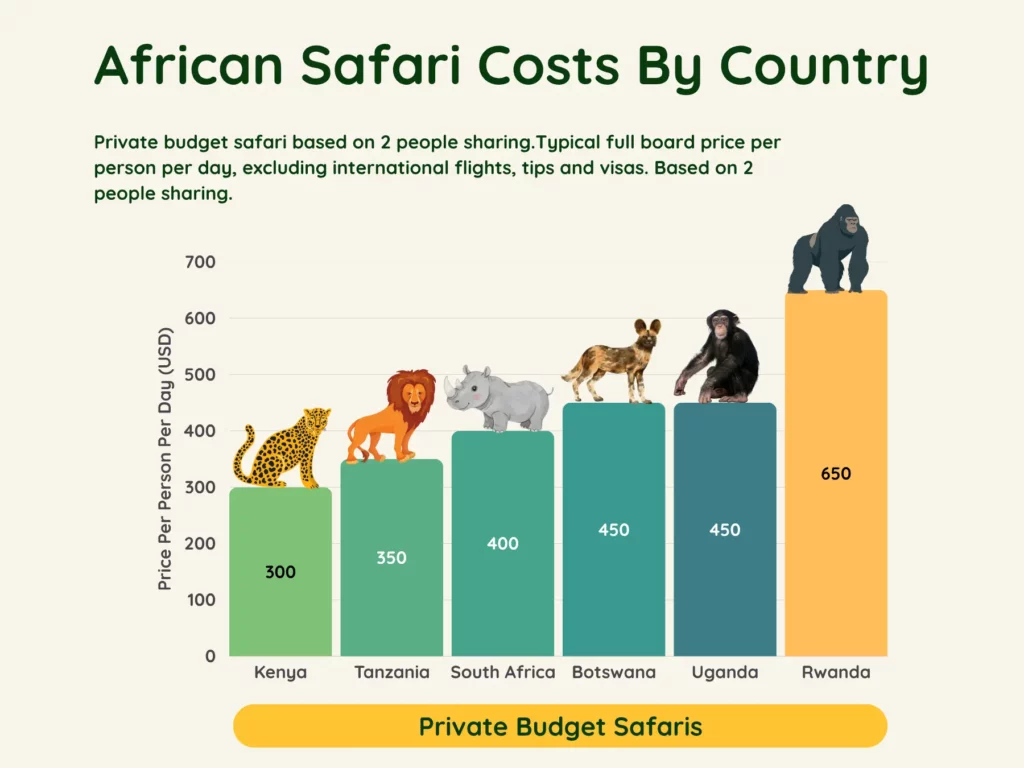
| Destination | Private Budget Safari Cost PP/Day |
|---|---|
| Kenya | 300 USD |
| Tanzania | 350 USD |
| South Africa | 400 USD |
| Botswana | 450 USD |
| Uganda | 450 USD |
| Rwanda | 650 USD |
Cultural Experience Tours Costs
Kenya is very culturally diverse with at least 42 different tribes (ethnic groups) calling the country home.
For safaris of 5 days or greater, I would recommend incorporating at least one cultural activity into your safari – when done right, they can be one of the highlights of your trip. I had an incredible time visiting and talking at great length to a Maasai tribe near the Masai Mara.
However, it’s important to note that some cultural activities have become a little commercialised and it’s important to tell your safari company you want an authentic experience. Typically the best safari companies will ensure that anyway but there is no harm in specifying it. I’ve found that the tribes which are located slightly outside of the typical tourist routes and are not as frequently visited will provide the most authentic and immersive experience.
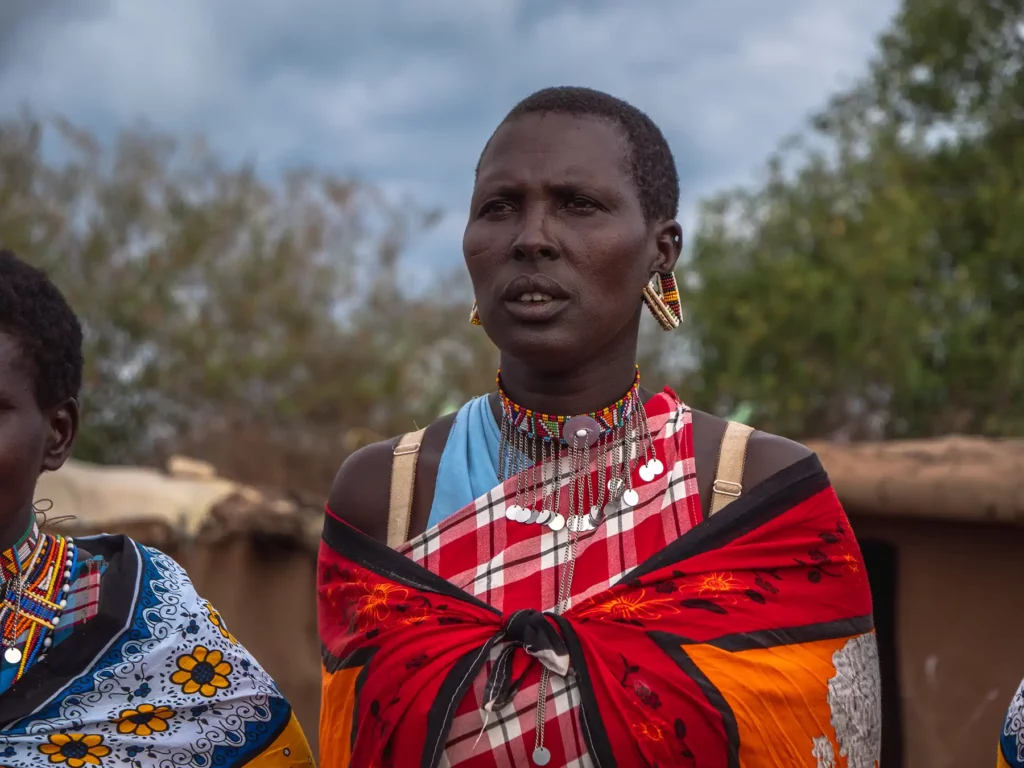
Cost for Visiting the Maasai in Kenya
The Maasai tribe are one of the most famous tribes in the world, boasting their distinctive dress and jumping dance. I was recently told that the name means the ‘Maa’ speaking ‘Sai’ people.
The Maasai are fearless warriors and I’m told that part of the reason for the lack of historical poaching in Amboseli is that the poachers feared them.
The cost to visit the Maasai tribe in Kenya varies from $30 – $80 per person depending on the specific village.
When you visit the Maasai, you will usually be greeted by their famous jumping dance. The men of the village show their strength by jumping as high as they can and this is also how they win female attention. You might even be given the chance to join in on the dance yourself!
You will also see their houses which are made from mud and sticks and learn about their culture and way of life.
At the end of the visit you will usually be given the chance to purchase their handmade jewellery. There is no obligation to purchase anything as you or your safari company have already paid for the visit, however I always like to support them in this way. See my souvenirs section for guide prices.

Cost for Visiting the Samburu Tribe in Kenya
Like the Maasai, the Samburu are semi-nomadic pastoralists who herd mainly cattle but also keep sheep, goats and camels. They live in nomadic villages of round window-less huts made from sticks, mud and cow dung, called manyatta and dress in vibrant tribal costumes.
The tribe are located around the Samburu National Reserve in north-central Kenya. You may also hear them referred to as Lokop or Loikop as this is the name they use themselves.
The cost to visit the Samburu tribe on the edge of the Samburu National Reserve is usually around $30 – $50 per person.
Special Interest Safari Costs
Special interest safaris such as birding, photography and hot air balloons often require specialist equipment such as a customised photography safari vehicle as well as specialist guides such as a bird spotting expert.
These extra requirements can make specialist safaris more expensive than standard safaris. However, with a 14 day birding safari for example, if much of the time is spent in more remote and lower cost parks which are nonetheless great for birding, this will bring down the average cost per day compared to a 5 day standard safari with spends 3 days in the Masai Mara with it’s high park fees.
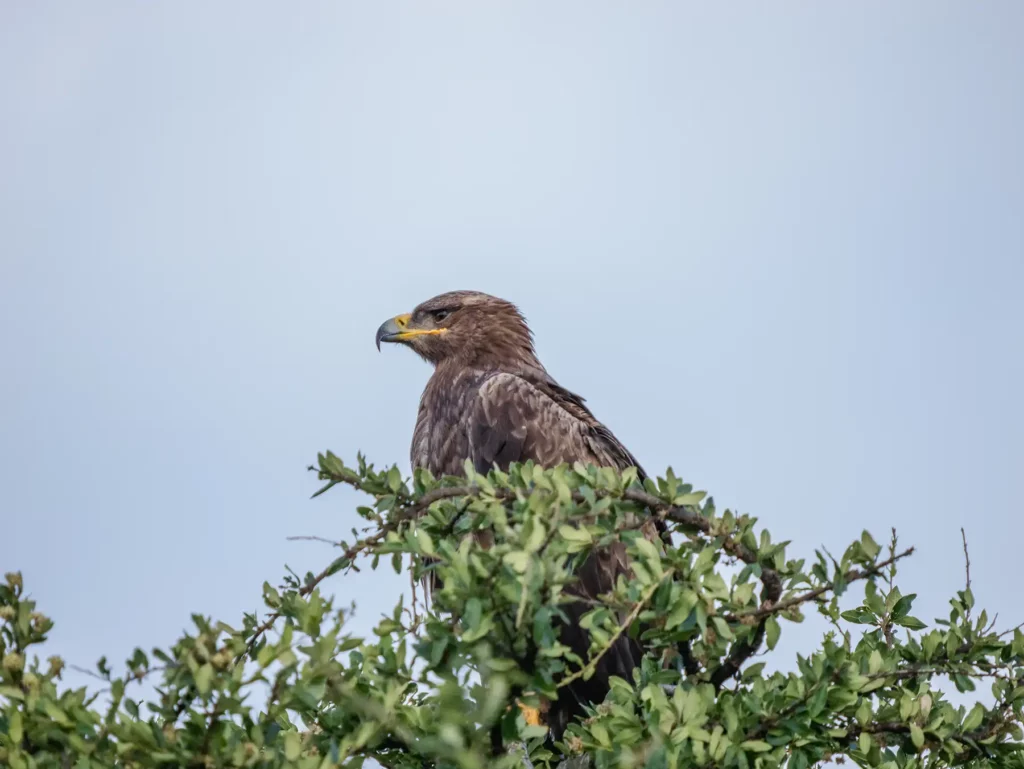
Birding Safari in Kenya Cost
With an incredible 1158 confirmed species of birds in Kenya, the country is very popular with bird watchers who can see as many as 400 species of birds during a 2-week birding safari.
Kenya’s bird diversity is only rivalled in Africa by Democratic Republic of the Congo and Tanzania.
Highlights include Kakamega Forest, which is famous as one of Africa’s top birding locations, and Amboseli and the Masai Mara. Other great birding locations in Kenya include The Rift Valley lakes; Lake Naivasha, Lake Nakuru, Lake Baringo and Lake Bogoria.
Birding safaris typically cost an extra $50 – $100 per person per day on top of the usual safari costs and tend to span 10 – 20 days or more.
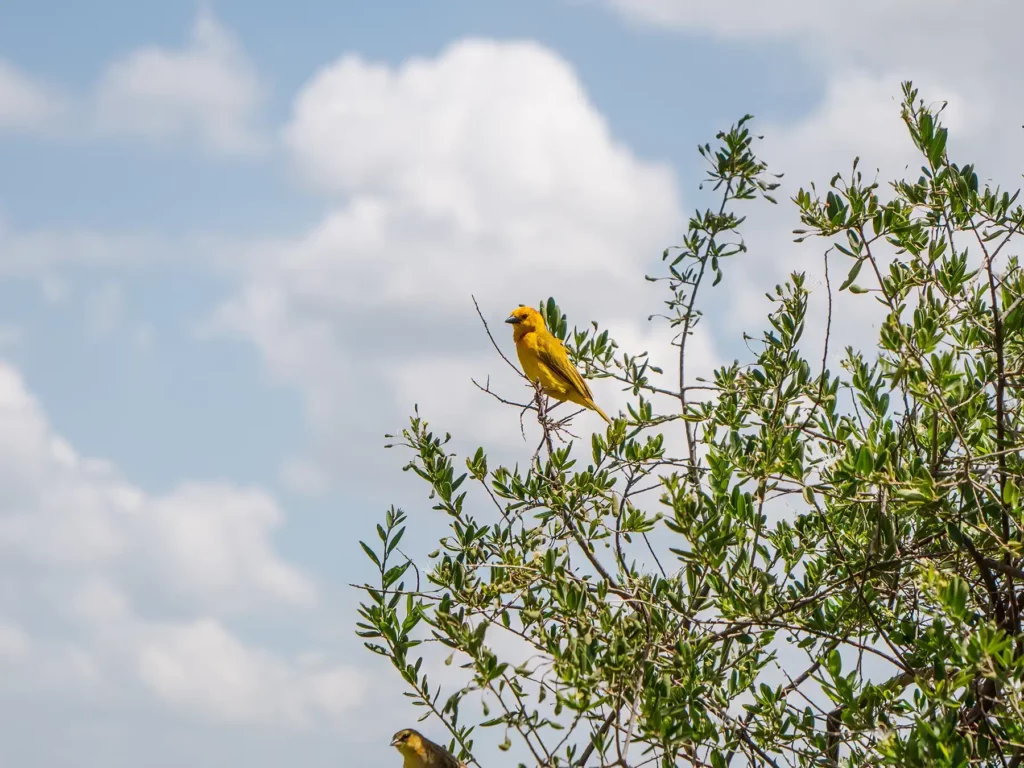
Photography Safari in Kenya Cost
Photography safaris are safaris which are focused on helping you achieve the best possible wildlife photographs.
Photography safaris may have a guide who is experienced with helping photographers get the best wildlife shots. At the higher-end, the safari may include a professional photographer who will direct the driver in finding the best photography opportunities as well as providing photography guidance to the guests.
Often photo safaris will use a specialist photography safari vehicle with large open windows along the sides to allow for lower level shots in addition to the usual popup roof.
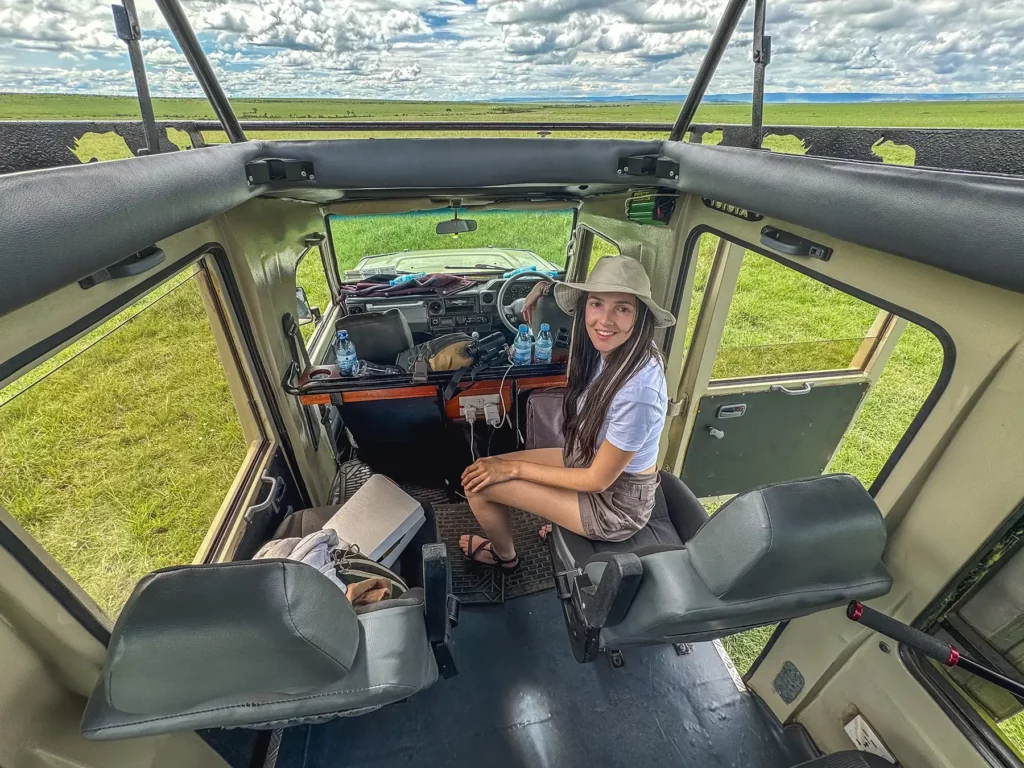
A typical photography safari will typically cost an extra $50-150 per person day on top of the usual safari prices. If the trip involves being joined by a well known photographer then prices could exceed this.
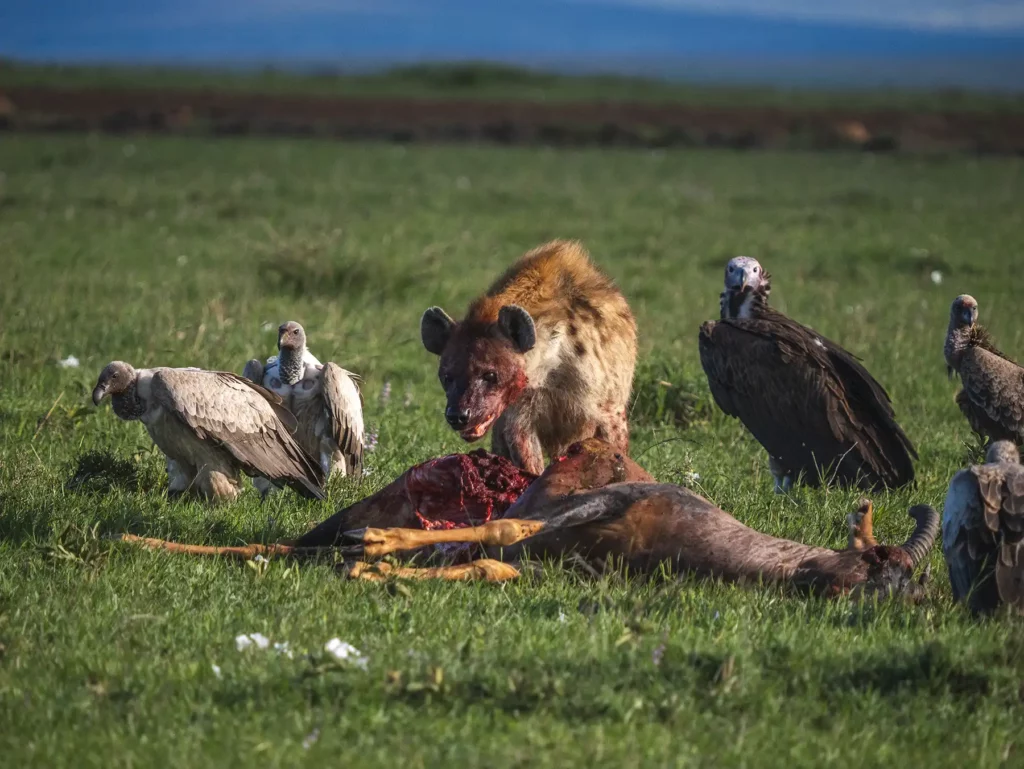
Hiking and Walking Safari in Kenya Cost
Hiking and walking safaris are great ways to get closer to nature and experience the environment in a more immersive way.
Although growing in popularity, walking safaris are reasonably new to Kenya and currently only driving safaris are permitted in most of Kenya’s national parks and reserves, such as the Masai Mara Reserve, Samburu and Tsavo.
Walking safaris aka bush walks are however often possible in private ranches and the wildlife conservancies which often sit on the edges of the national parks. Your guide will usually carry a firearm for your safety.
Due to the increased risk of a walking safari, you may wish to use an experienced guide.
The KPSGA (Kenya Professional Safari Guides Association) is an example of a guide certification programme.
Walking safari usually costs around $150 – $200 per person per day.
Balloon Safari in Kenya Cost
Balloon safaris provide a birds-eye view of the landscape as well as the wildlife.
Typically setting off just before sunrise, hot air ballon safaris usually last around an hour.
For safety reasons you will only be allowed to take off in calm conditions, so please remember that balloon safaris are subject to weather on the day and are not guaranteed. You will of course be refunded if take off isn’t possible. I’ve heard of tourists demanding the balloons take off, against the operators guidance, even in bad conditions – this is not wise as the high safety record of hot air balloons is significantly compromised in bad conditions so it’s not worth the risk.
Balloon Safaris in Kenya, often over the Masai Mara, are a great experience if you have the budget and typically cost $550-650 per person.
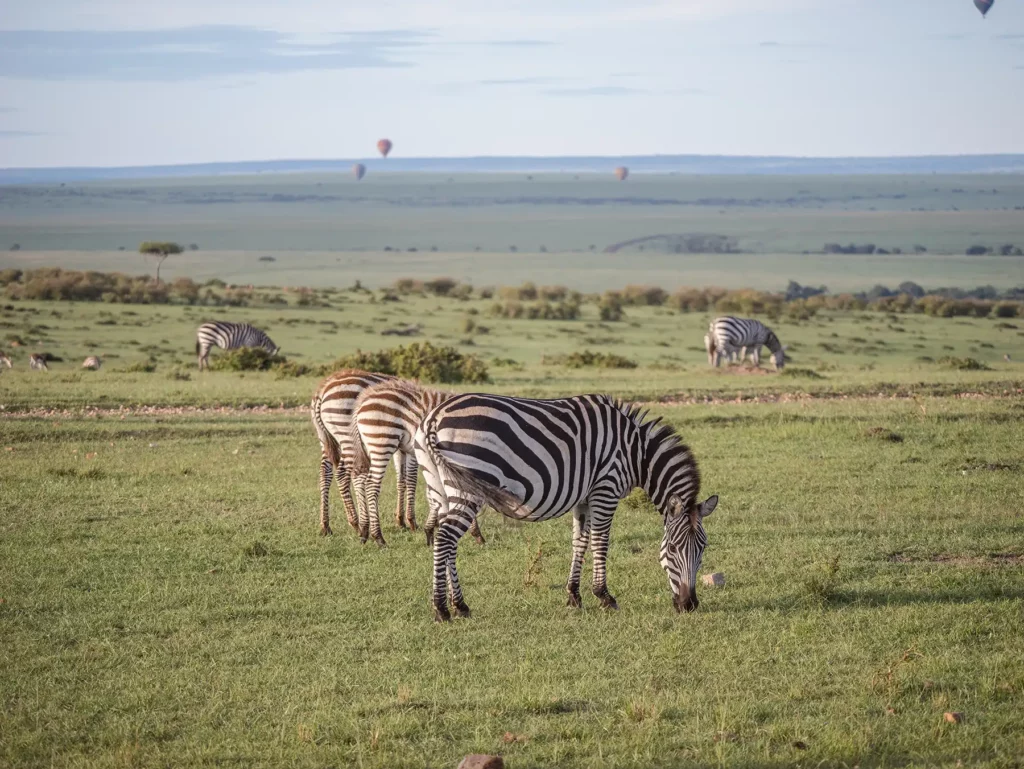
Mount Kenya Hiking Costs
Two hours north of Nairobi, Mount Kenya is the second highest peak in Africa.
Whilst it’s possible to summit and descend in three days this isn’t recommended as you ideally want to allow time to acclimatise to the altitude. At least four to six days is recommended depending on the route chosen.
Technically Mount Kenya can be climbed all year round. However, between June and October is best for routes on the north side and December to February for routes on the south side.
Hiking Mount Kenya typically costs around $200 per person per day. However, this can vary based on group size, time of year, the route taken and total trip length.
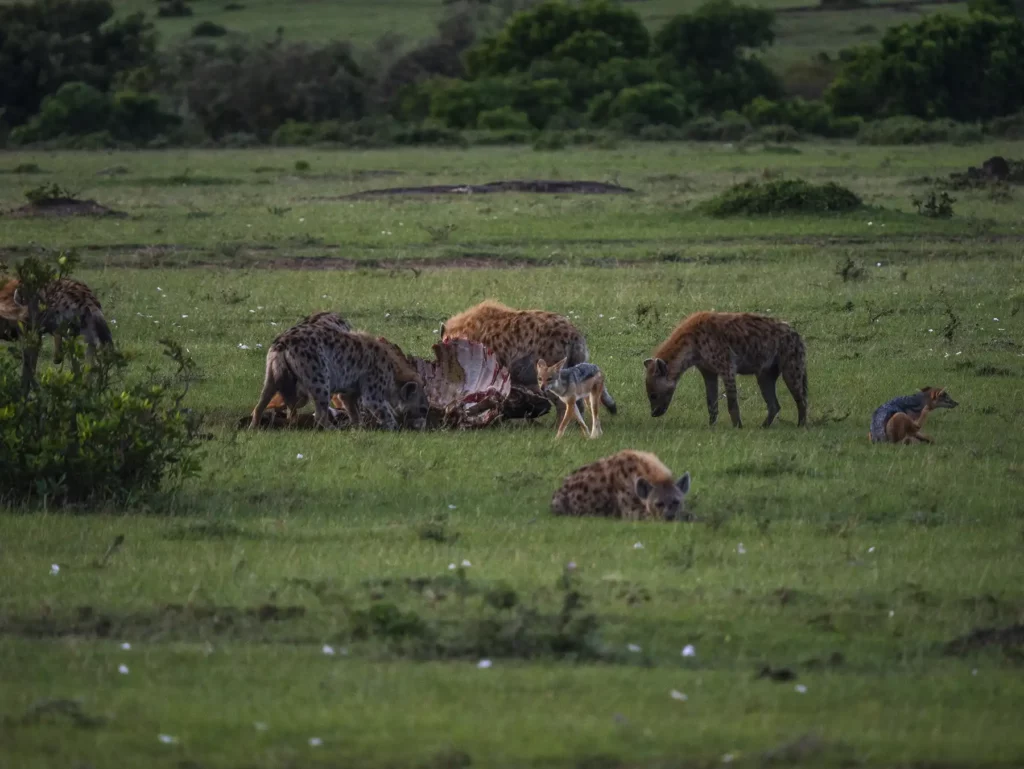
Other Safari Costs
Rates quoted by safari companies usually don’t include the costs below, as well as excluding international flights.
Tips / Gratuities
Tipping is part of the culture in Kenya. It’s preferred to tip in USD but you can also tip in Kenyan Shillings, Euros and GBP.
I would normally tip my driver guide $20 per day, for a party size of two i.e. $10 per person in the party. If they have been exceptional, I may go slightly higher. Some safari companies have their own recommended tipping rates which may help them attract the most experienced guides.
It’s recommended to give your guide their tip at the conclusion of your safari.
Tipping in accommodation is at your discretion. If you wish to leave a tip, you can do so by leaving the tip in the tipping box at the end of your stay. Guideline tips are $5 per adult per night depending on the level of service.
You’re not typically expected to tip the Maasai or other tribes if you visit them. Instead you can buy some souvenirs from their shops to show your support and appreciation. See my souvenir price guides later in this guide for how much to pay.
Visas
You no longer need a visa to visit Kenya. You now need to apply instead for Electronic Travel Authorization (eTA).
An eTA costs $30 USD per person.
Check latest guidance on your Gov website e.g. US / UK.
You can apply for your eTA here.
Souvenirs
Bartering is part of the culture and it’s not uncommon to have the starting prices over 50% higher than the target price.
I find that setting my price slightly lower than I’m prepared to pay and just sticking to it and walking away if necessary does the trick of getting a compromise at my target price.
I probably end up paying a little over the odds but I’m happy to support the local tribes whilst at the same time I don’t like to get fleeced.
The lowest prices are usually achieved in Nairobi.
Guide prices based on my recent experiences:
Hand-made metal bracelet: I’ve paid between $5 – 15 USD with asking prices around $30
Hand-calved animal in ebony 15x30cm: I paid $20 USD (asking price was $40)

Clothing
You may well already have some suitably coloured clothing for your safari, in which case the clothing won’t cost you anything.
The weather in Kenya can fluctuate in the day from very cold to very hot. Therefore you’ll want to bring lots of layers.
I like to wear a vest-top (tank-top) beneath a linen shirt and then a nice snuggly jumper on top. I gradually take layers off as the day gets warmer.
In terms of trousers / pants, I either wear long trousers or shorts depending on if the day will be warm or not.
Bring a waterproof coat in all seasons.
Lodges don’t require formal wear for the evenings so you can save some space and weight by wearing casual attire.
The colour of the clothing you bring is very important and even more so if you’re going on walking safaris. Neutral colours are best to bring. Beiges, browns, muted greens and greys are my favourite colours to wear for safari.
You’ll want to avoid blacks, dark blues, bright colours or white as these can disturb animals and attract the pesky tsetse fly.

Vaccines & Medication
The cost of travel vaccinations at a travel clinic for patients without health insurance typically includes:
An initial consultation fee of $15 to $100.
A shot administration fee of $10 to $20 per shot.
The cost of the vaccines, which can range from less than $10 per dose to $150 or more per dose.
You can find information about recommended vaccinations below:
US citizens Guide to Kenya vaccines
UK citizens Guide to Kenya vaccines
Anti-malarial tablets are also recommended for Kenya and these cost around $2 per day. You would typically take the tablets for a few days before your trips and some time after. Please check instructions for your specific Anti-malarial tablets.
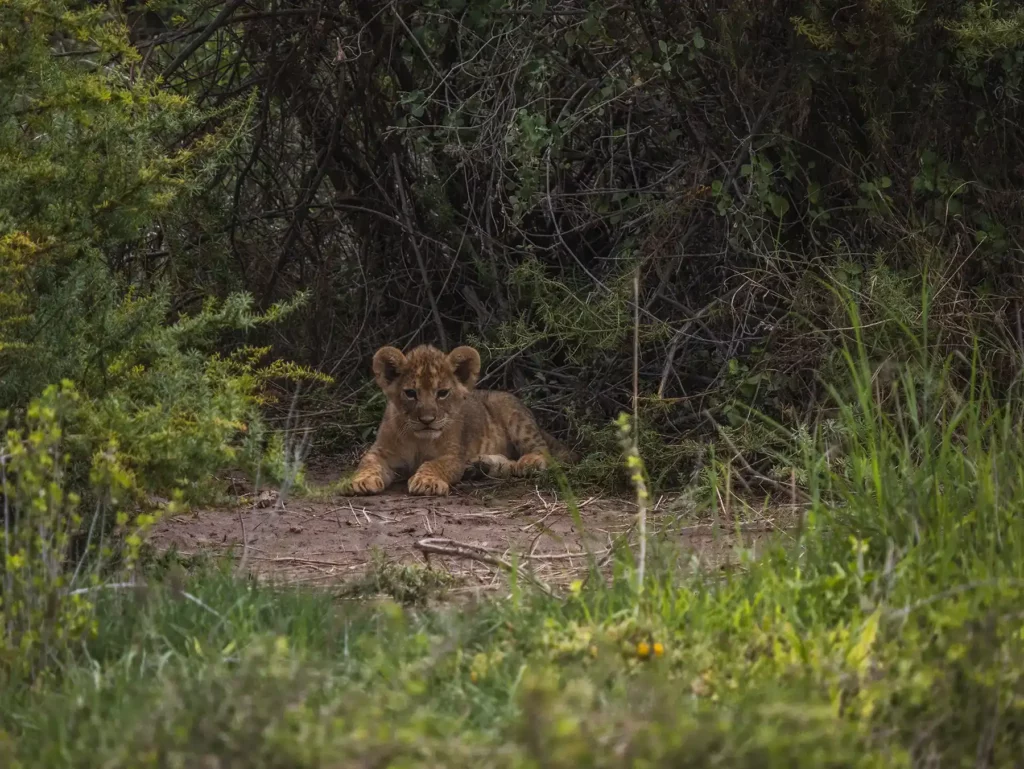
How Much Cash To Take
You can pay for most costs on your card. I found it easy enough to draw out money on my Visa Cards but Mastercard only seemed to work infrequently. Both cards worked fine for paying for costs on chip and pin machines.
Remember to tell your bank that you’re travelling through their App or over the phone to ensure they don’t auto-flag your overseas transactions as potentially fraudulent and block your transactions by mistake.
Currencies which are windy accepted are Kenyan Shillings and USD.
The things which I used cash for were:
Tips: Budget around 20-30 USD per person per day in total for tips for your driver, porters, other guides etc.
Buying Souvenirs and small purchases at markets: Around $35 for a handmade necklace etc. You might wish to take $200 for souvenirs.

Final Thoughts
Kenya is a fantastic choice for your safari. Housing some of the best national parks and reserves in the world, you’re pretty much guaranteed to see plenty of wildlife here. In order to see the best of Kenya, I’d highly recommend a 7-10 day itinerary although a 5 day itinerary would still allow you to see the best safari locations in Kenya.
With prices for a private safari starting at around $300 per person per day, I’d class Kenya as a mid-range safari destination. It’s similar in price to Tanzania but is nowhere near as expensive as a safari in Botswana or gorilla trekking in Uganda or Rwanda. Direct flights to Nairobi from several European countries also make Kenya extremely accessible and not an expensive destination to fly to.
Read More Kenya Guides
Kenya Itineraries
Recomended itineraries and how to book them.
7-10-Day Kenya Safari Itinerary
3 Day Kenya Safari Itinerary & Costs
2-Week Kenya Safari Itinerary & Costs
Kenya & Tanzania Itineraries
Multi-country itineraries and how to book them.
10-Day Kenya and Tanzania Safari Itinerary
2-Week Kenya & Tanzania Safari Itinerary
Costs & Planning
How to get the most bang for your buck and the best time of year to visit depending on what you want to do and see.
Kenya Safari Costs – Everything you Need to Know
The Great Wildebeest Migration Guide
National Parks & Reserves
Complete guides to the best and most famous safari reserves, including the wildlife you’ll see, entrance costs and best time to visit.
Coming soon.
Other Popular Safari Destinations
How to Book Your Safari
Save time and ensure an incredible safari experience by getting quotes from my recommended local safari companies.
Join the rapidly growing tribe of over 1,000 travellers who’ve booked their dream safari using my insider tips and recommendations.

what size telephoto lens do you recommend for a safari?
I use a 100-400mm lens (on a micro four thirds camera so in reality it’s 200-800mm) and I absolutely love it. It is versatile and it’s very rare that an animal is too far away from me. Prime lenses are a lot more expensive, far heavier and less versatile so although the results may be slightly better, I wouldn’t recommend it if it’s your only lens.
Hello Ella! Very good article! Thanks for all those recommendations! Do you think it is possible to get a budget tour beginning in nairobi and going to maasai tribe, serengeti, ngorongoro, kilimanjaro, and then ending in dar es salaam?
Hey Marcelo! Tours typically end in Arusha / Kilimanjaro so everything up until that point (Nairobi – Kilimanjaro) can certainly be arranged by one tour company. You’ll then just need to purchase a flight from Arusha / Kilimanjaro to Dar Es Salaam and potentially arrange for a tour in Dar Es Salaam, if that’s something you’re interested in.